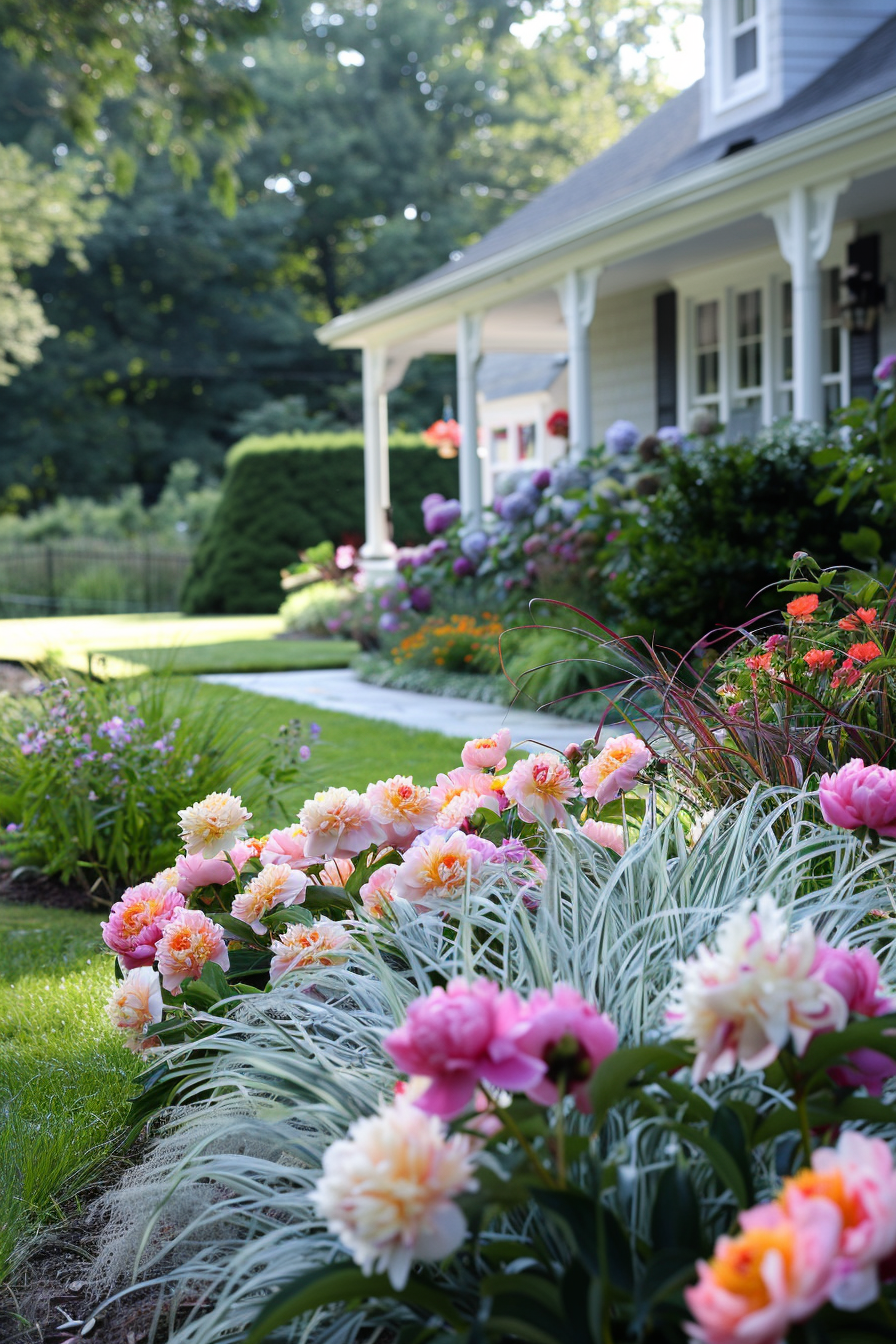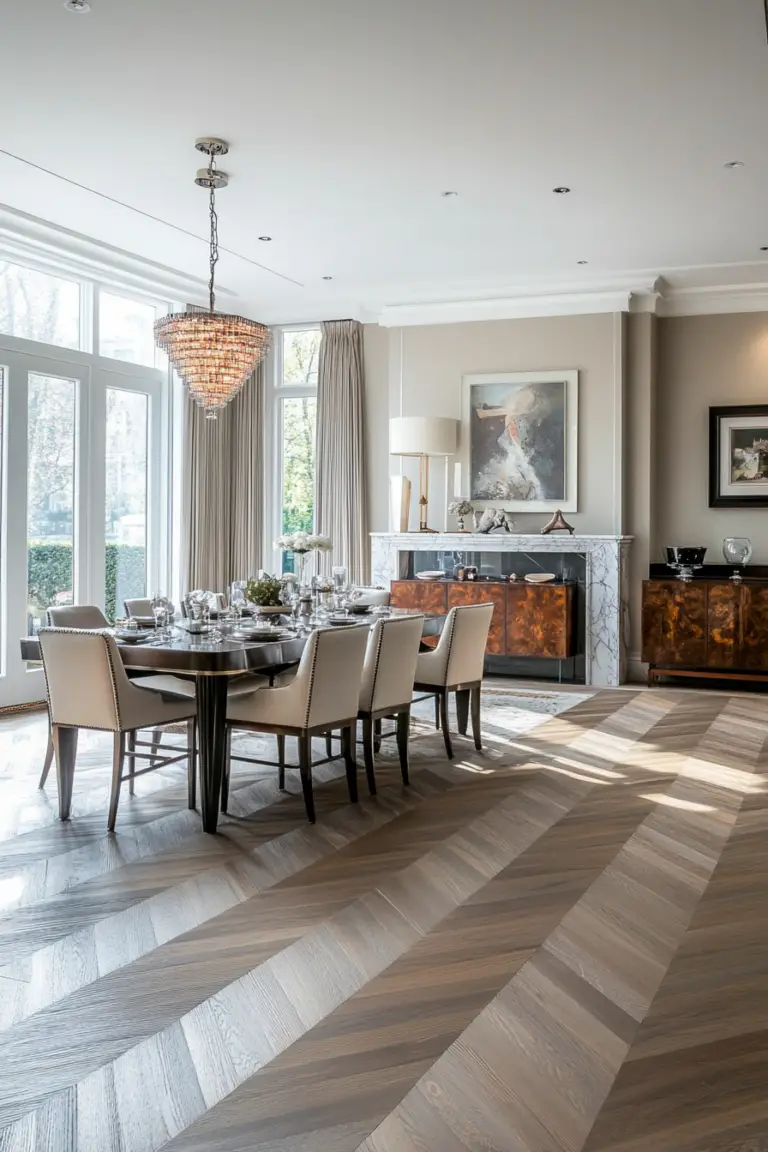The Landscaping Plants You Need If You Have a USDA Zone 6 Front Yard
Creating a stunning front yard that thrives in USDA Hardiness Zone 6 involves choosing the right combination of plants. From vibrant flowers to evergreen shrubs, the right selection can provide year-round interest and curb appeal. Here are 15 essential landscaping plants, perfectly suited for Zone 6, to help transform your front yard into a captivating and welcoming space.
1. Peony and Japanese Maple: A Harmonious Duo
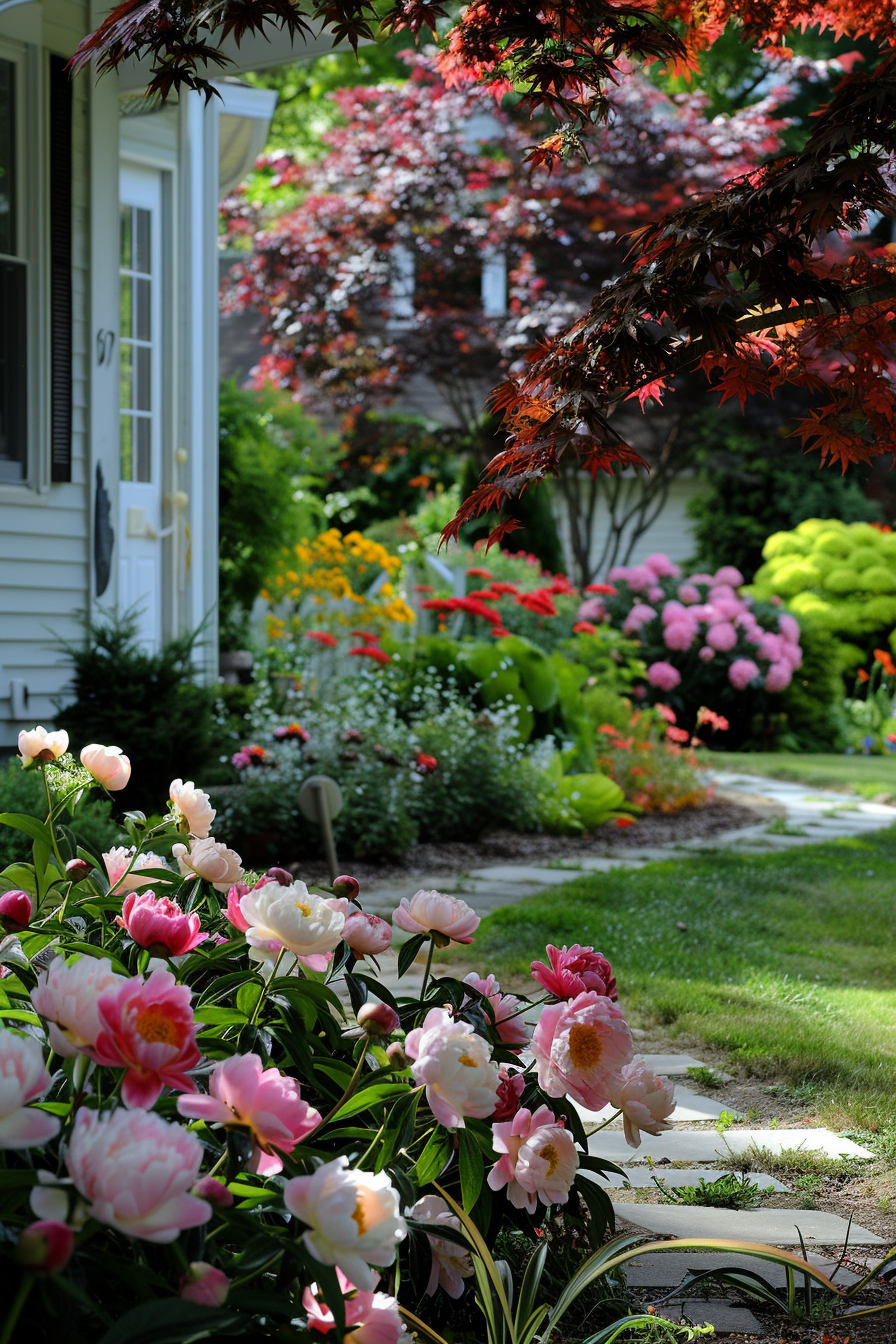
Peonies (Paeonia lactiflora) are beloved for their large, fragrant blooms that add a touch of elegance to any garden. These perennials are best planted in a spot that receives full sun to partial shade. When paired with the delicate, lacy foliage of a Japanese Maple (Acer palmatum), they create a stunning contrast. The peony’s lush flowers, available in various colors, provide a vibrant pop against the Japanese Maple’s graceful, red or green leaves. Together, they form a breathtaking display of texture and color that enhances any front yard.
To maximize the impact, plant peonies in clusters along pathways or borders where their lush blossoms can be admired up close. Position the Japanese Maple as a focal point in the yard, where its elegant canopy can provide dappled shade. This pairing works well in both formal and informal garden designs, offering a blend of structure and softness that appeals to the eye throughout the growing season.
For added visual interest, consider planting groundcovers or low-growing perennials around the base of the peonies and Japanese Maple. This will create a layered look, filling in gaps and adding depth to your landscape. With the right care, this combination will provide a stunning focal point in your front yard for years to come.

2. Smooth Hydrangea and Boxwood: Classic Elegance
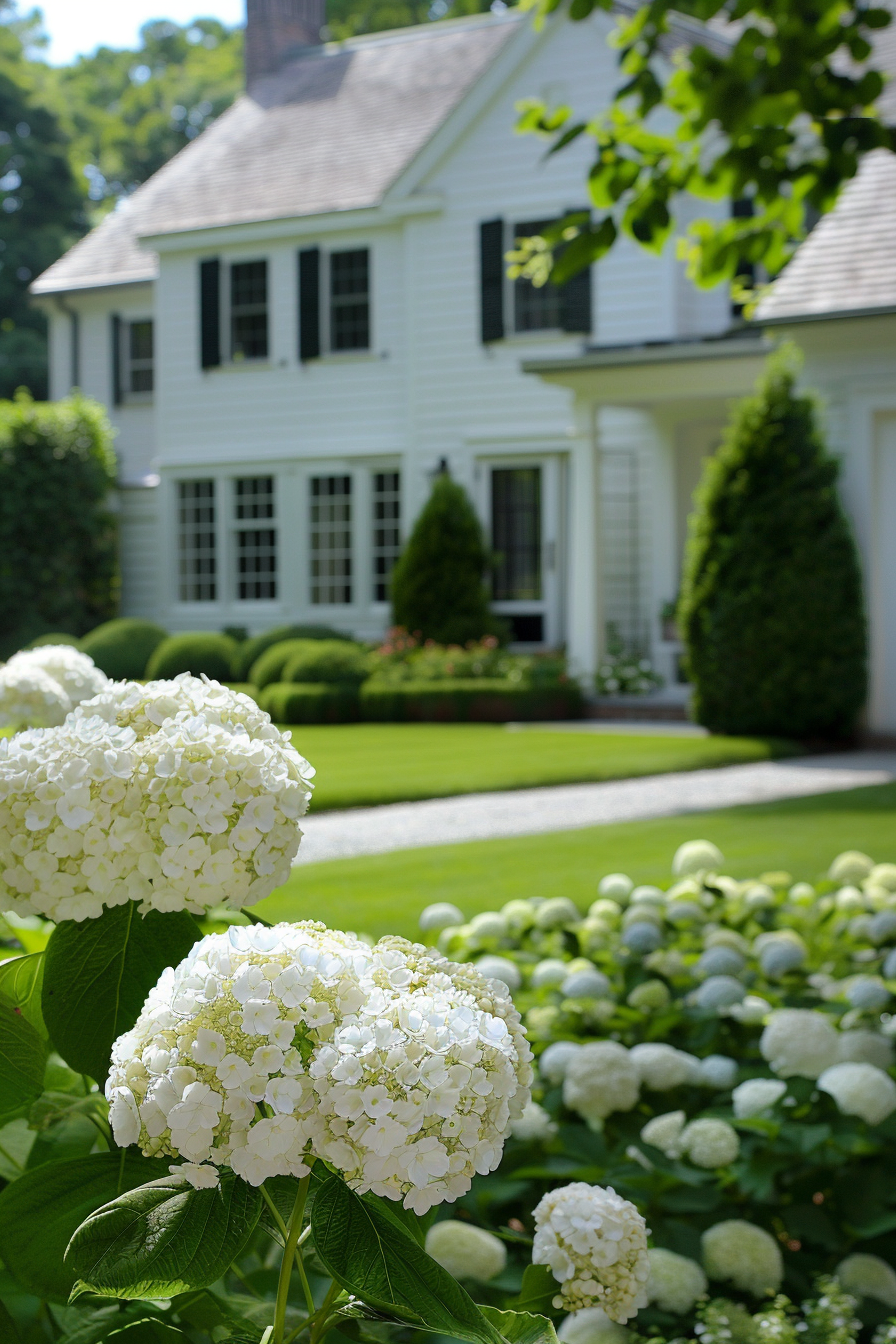
The Smooth Hydrangea (Hydrangea arborescens ‘Annabelle’) is renowned for its large, globe-like clusters of white flowers that bloom from early summer to fall. When paired with the neat, evergreen foliage of Boxwood (Buxus sempervirens), this combination creates a timeless and sophisticated look. Hydrangeas thrive in partially shaded areas and prefer well-drained, fertile soil. Their abundant blooms provide a striking contrast to the dense, glossy leaves of Boxwood, which can be shaped into hedges or topiaries for a formal appearance.
Plant Smooth Hydrangeas as standalone specimens or in groups to create a mass of showy flowers. Position Boxwood along walkways, driveways, or as a backdrop to the Hydrangeas to frame the vibrant blooms. This combination is perfect for creating a structured yet inviting front yard, with the Boxwood adding year-round greenery and the Hydrangeas providing seasonal bursts of color.
To maintain the visual appeal of this pairing, regular pruning and proper soil care are essential. Ensure the Hydrangeas receive enough moisture and the Boxwood is kept trimmed to retain its shape. This elegant duo will lend a classic charm to your front yard, making it a welcoming sight for visitors and passersby alike.
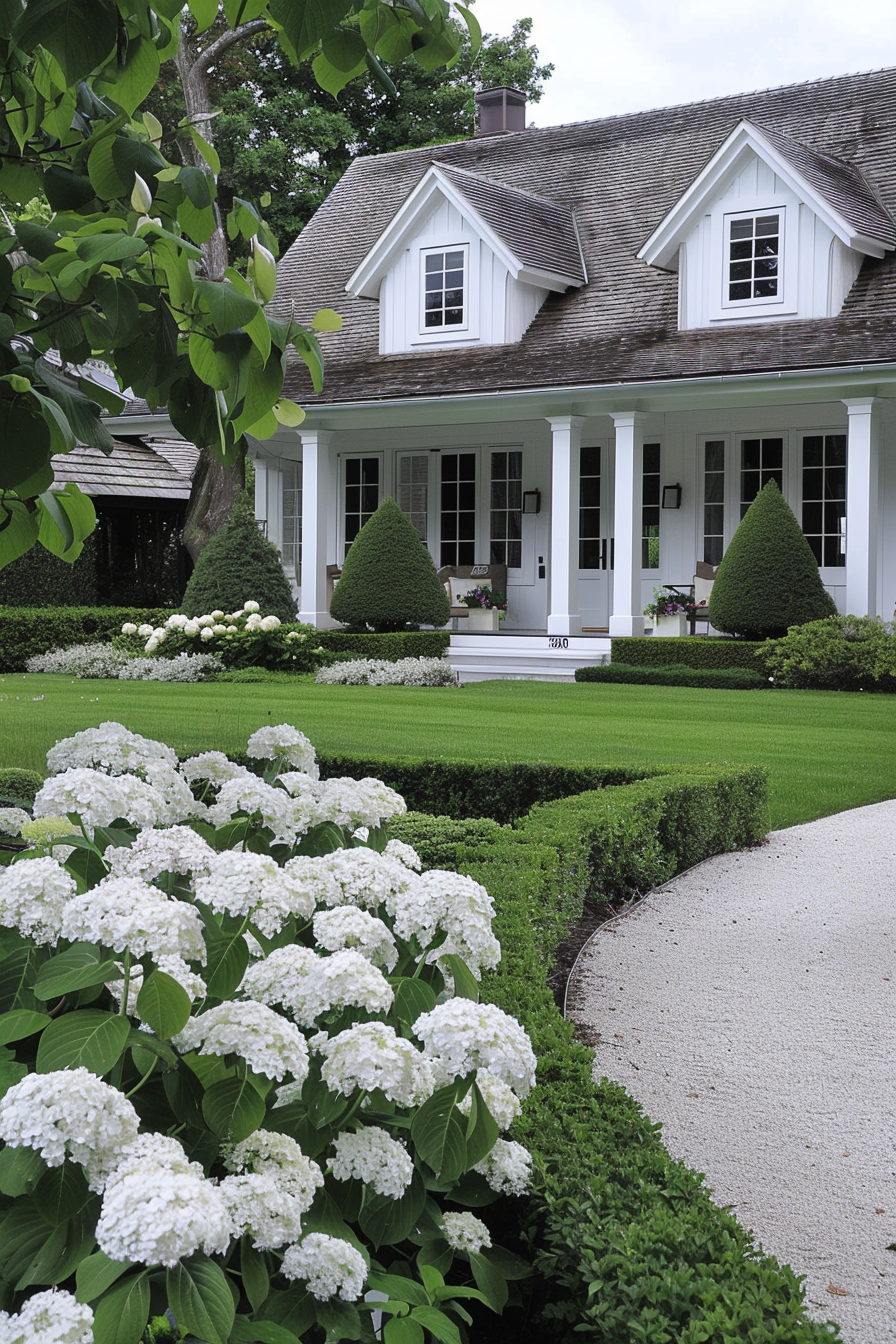
3. Purple Coneflower and Colorado Blue Spruce: A Rustic Touch
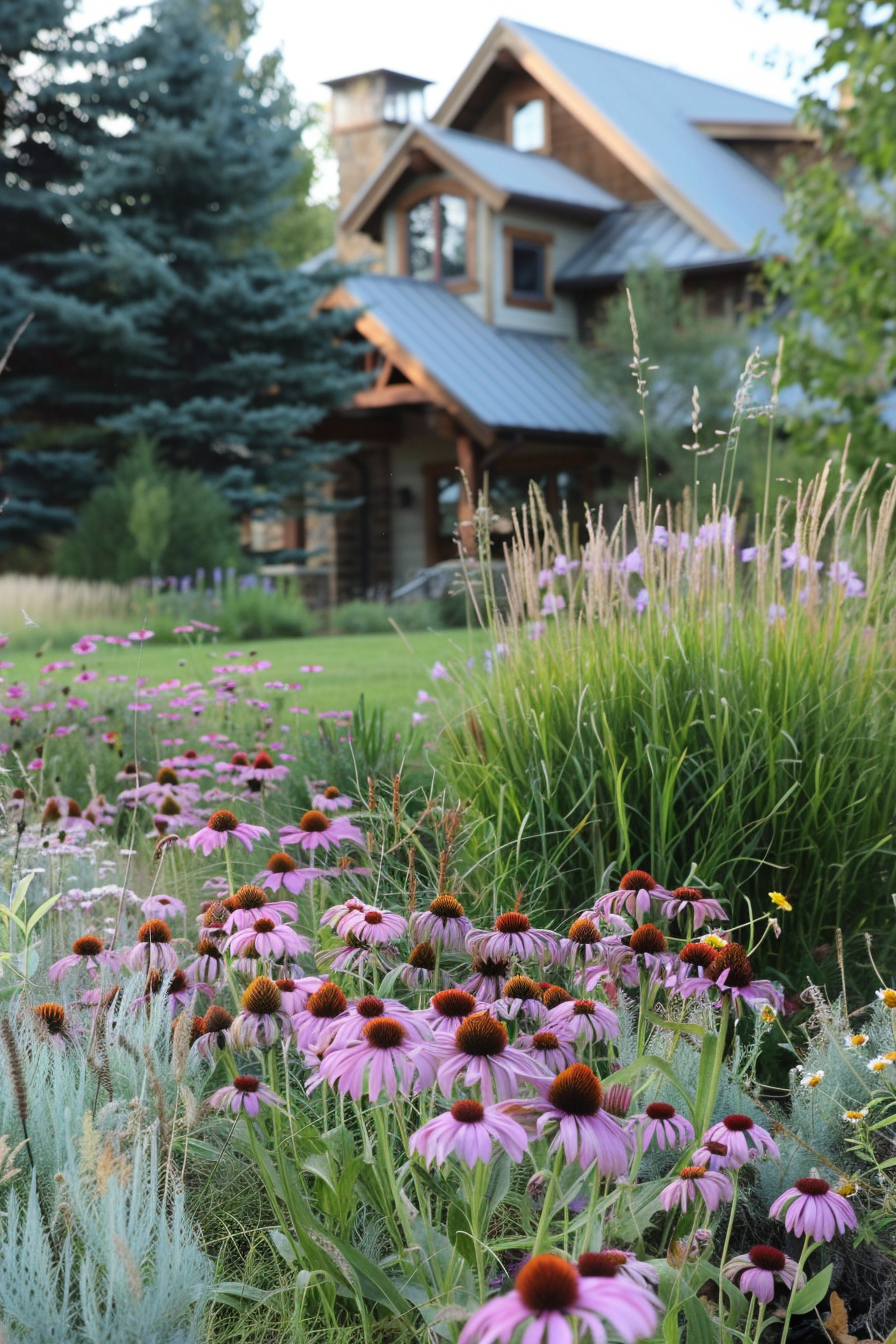
Purple Coneflower (Echinacea purpurea) brings a rustic, prairie charm to the garden with its daisy-like, purple flowers and sturdy stems. When paired with the stately presence of a Colorado Blue Spruce (Picea pungens), you create a dynamic landscape that combines the wild beauty of native perennials with the majestic silhouette of evergreen trees. Purple Coneflowers are drought-tolerant and thrive in full sun, making them ideal for sunny spots in your front yard.
Plant Purple Coneflowers in clusters or drifts along borders or in front of the Colorado Blue Spruce to highlight the tree’s blue-tinged needles. This combination offers year-round interest, with the Spruce providing structure and color during the winter months and the Coneflowers blooming from summer to fall. The contrasting colors and forms of these plants create a visually appealing scene that evokes a natural, relaxed atmosphere.
For a cohesive look, consider adding other native or drought-tolerant plants to complement the Purple Coneflowers and Colorado Blue Spruce. Grasses, sedums, or low-growing shrubs can help fill in spaces and provide additional texture. With minimal maintenance, this combination will bring a touch of rugged beauty to your front yard, welcoming you with its bold colors and resilient nature.
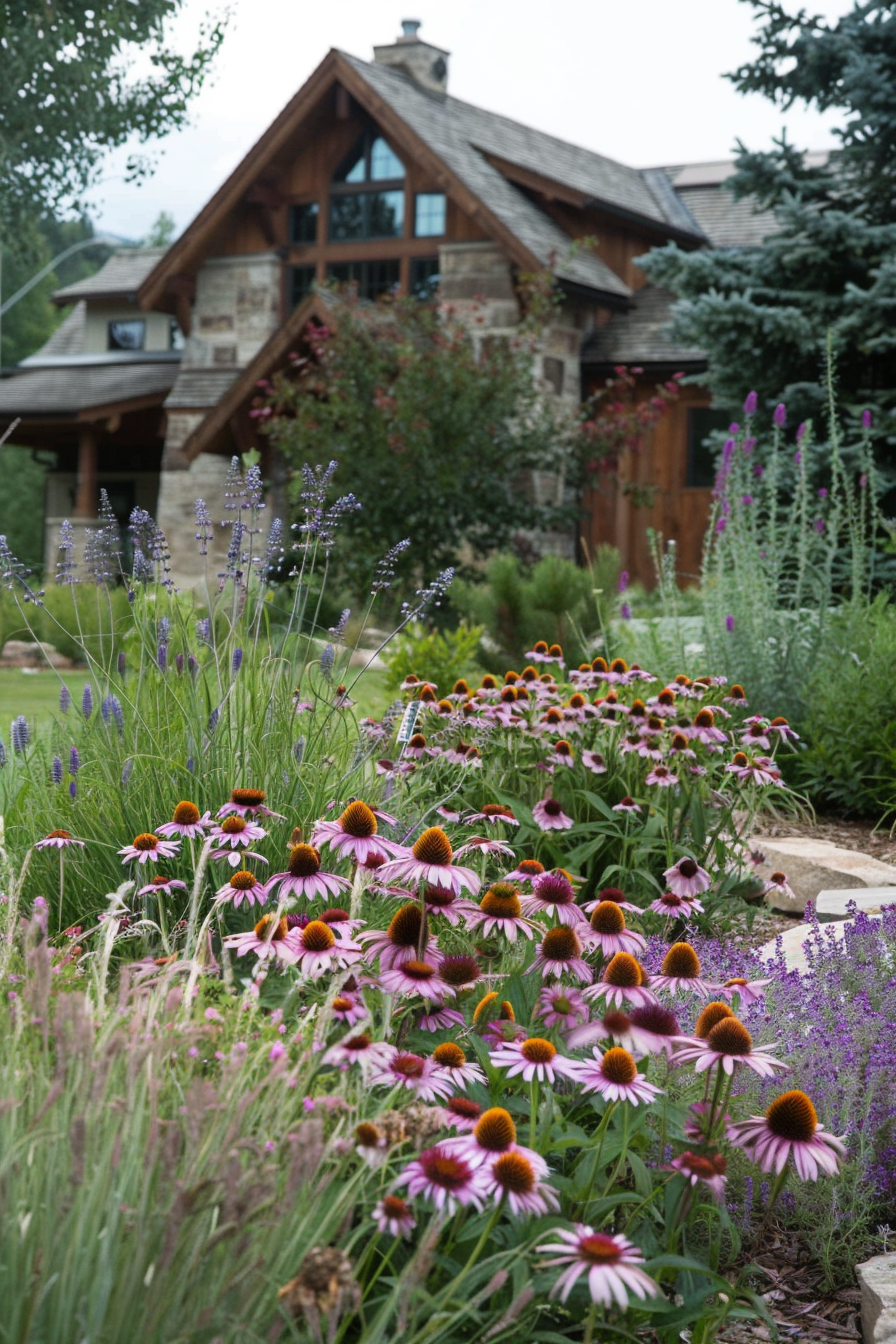
4. Daylilies and Maiden Grass: Effortless Grace
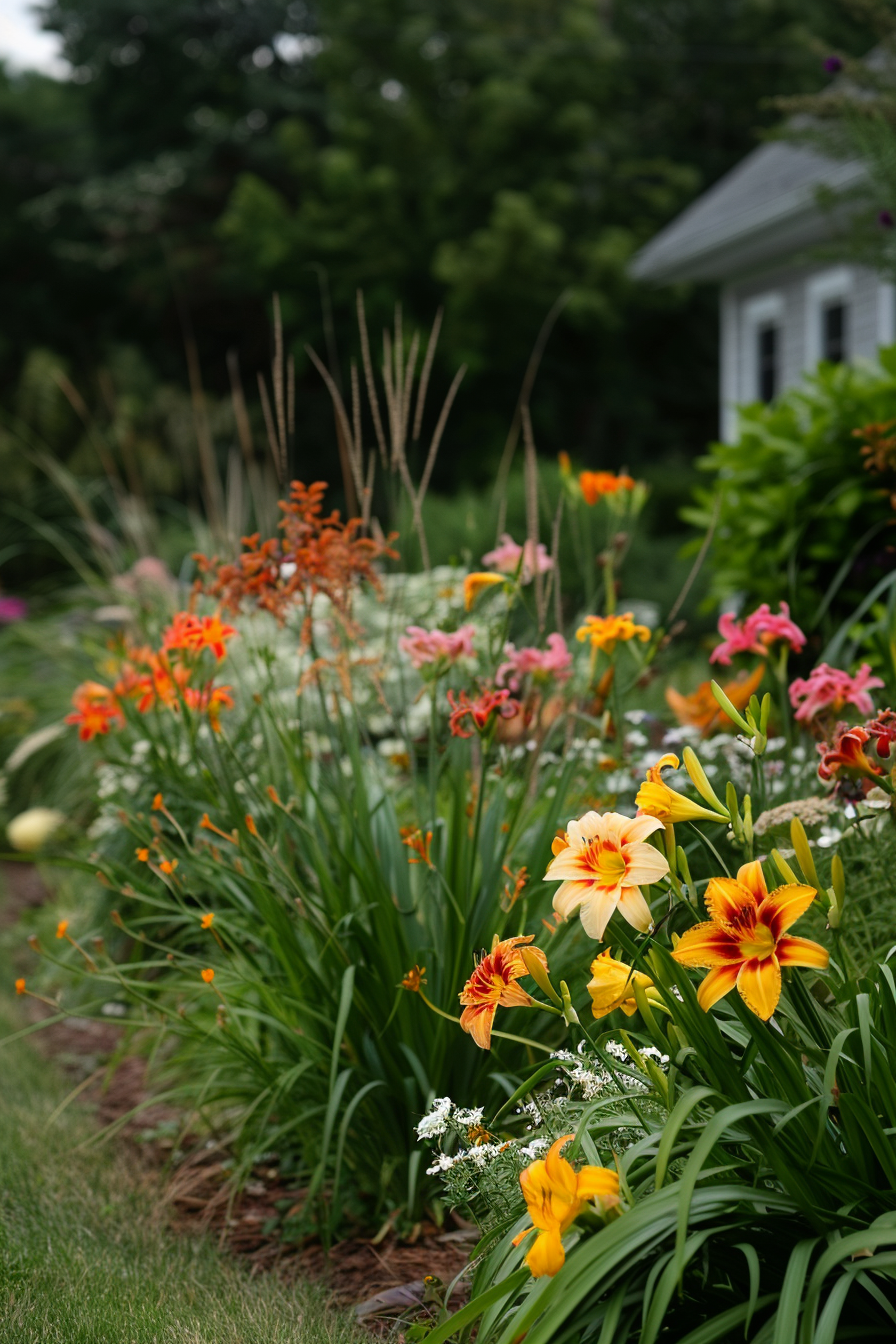
Daylilies (Hemerocallis spp.) are versatile and easy-to-grow perennials known for their vibrant, trumpet-shaped flowers that bloom throughout the summer. Their wide range of colors makes them a flexible choice for any garden design. Pairing Daylilies with the graceful, arching plumes of Maiden Grass (Miscanthus sinensis) creates a landscape that combines the lushness of flowers with the airy elegance of ornamental grasses. Maiden Grass adds texture and movement to the garden, especially when its feathery plumes sway in the breeze.
Plant Daylilies in drifts or clusters along garden borders, pathways, or in front of Maiden Grass to showcase their colorful blooms. Maiden Grass can be used as a backdrop or to create soft screens that add privacy while maintaining an open feel. This combination is perfect for creating a relaxed and naturalistic look in your front yard, with the Daylilies providing bursts of color and the Maiden Grass adding a sense of flow and continuity.
For a polished finish, consider adding groundcovers or low-growing perennials around the base of the Daylilies and Maiden Grass. This will create a layered, cohesive look that fills in gaps and enhances the overall design. With their low maintenance requirements and striking appearance, Daylilies and Maiden Grass will bring effortless grace to your front yard landscape.
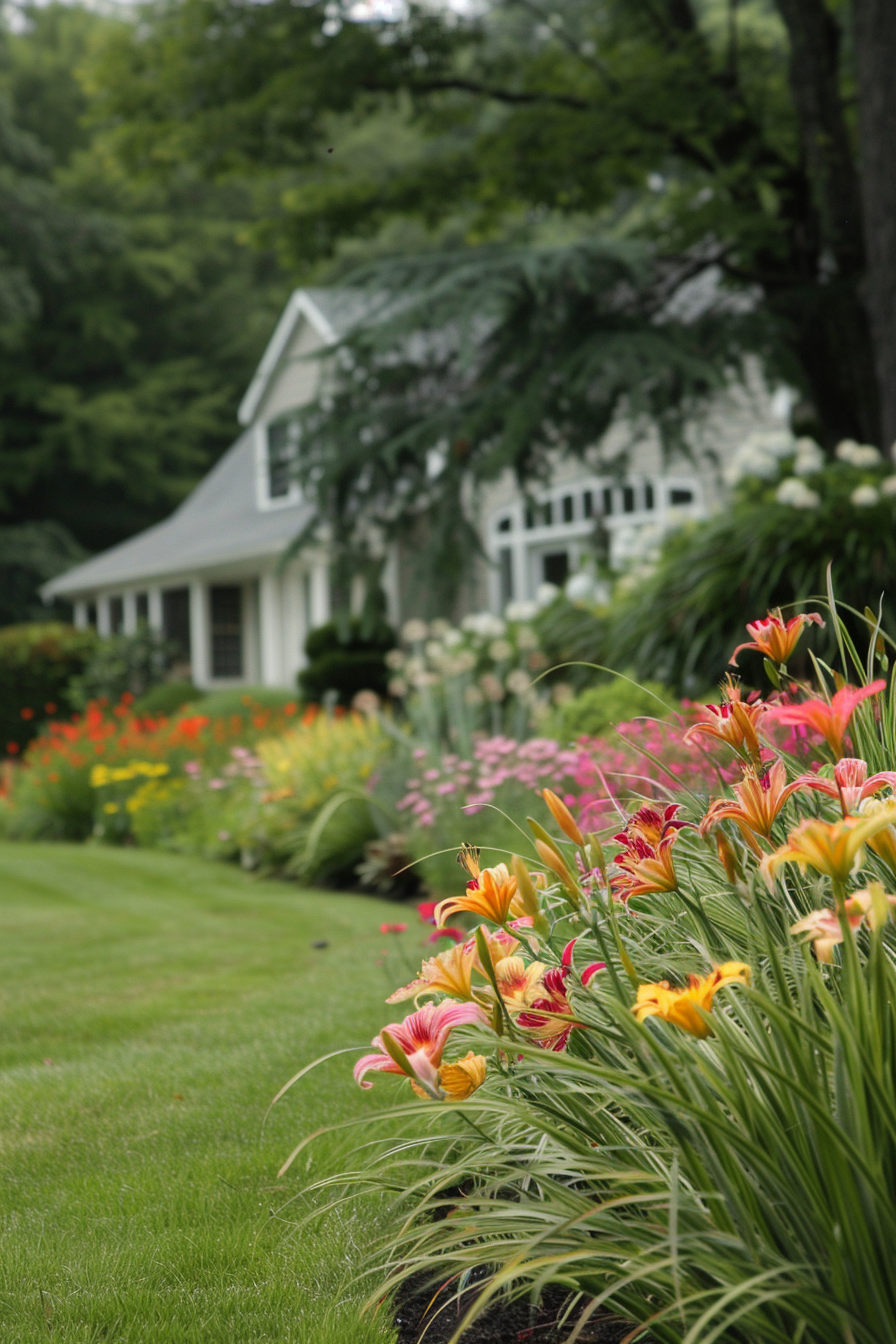
5. English Lavender and Boxwood: Aromatic and Evergreen
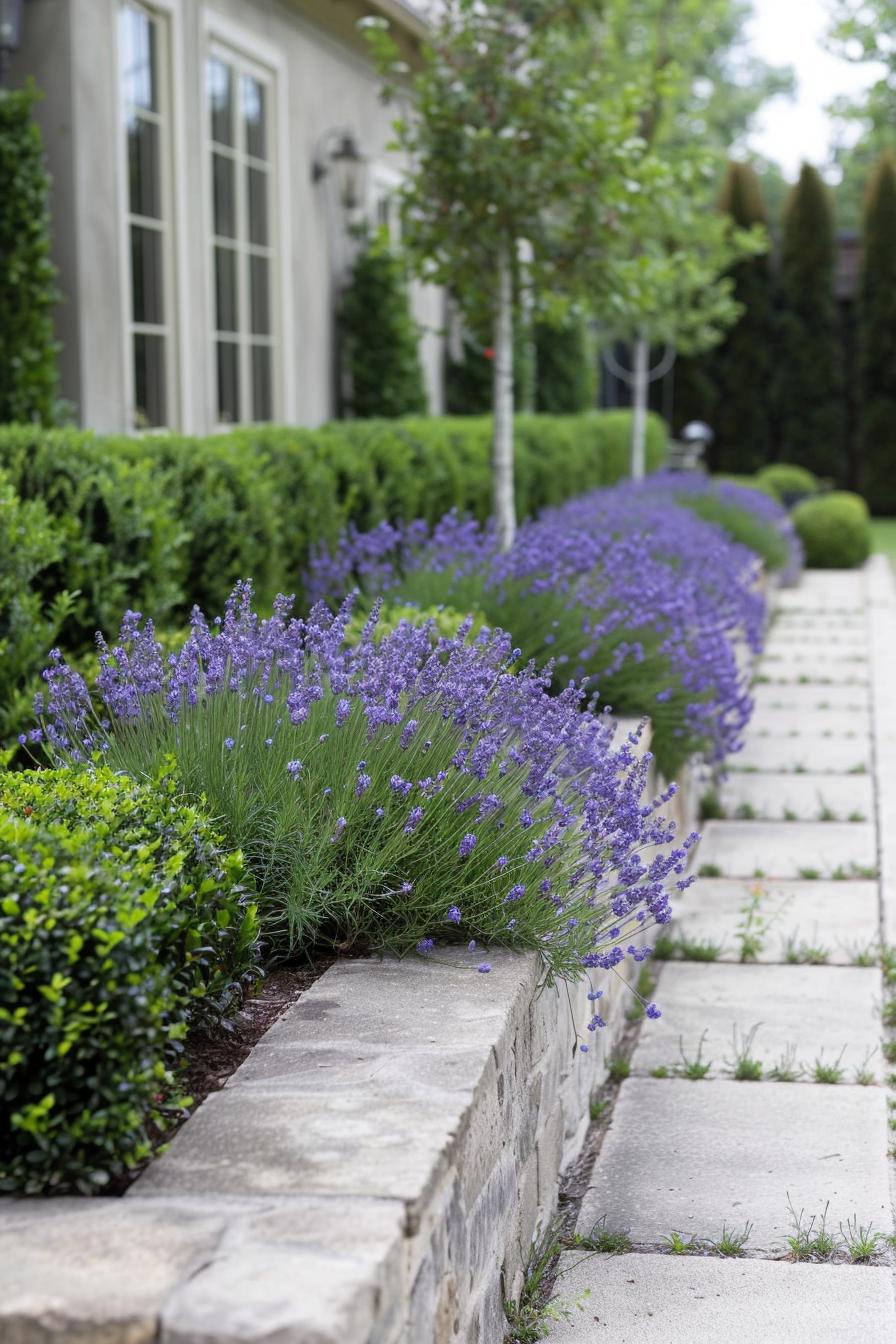
English Lavender (Lavandula angustifolia) is prized for its fragrant, purple-blue flowers and silvery-green foliage. This Mediterranean herb not only adds a delightful scent to your garden but also attracts pollinators such as bees and butterflies. Pairing Lavender with the evergreen structure of Boxwood (Buxus sempervirens) creates a classic, Mediterranean-inspired look. Boxwood’s dense, green foliage complements the airy, flowering stems of Lavender, adding both visual interest and year-round greenery.
Plant English Lavender in sunny, well-drained areas along borders, pathways, or in front of Boxwood hedges. The contrast between the Lavender’s soft, aromatic spikes and the Boxwood’s formal, tidy appearance provides a pleasing balance of textures. This combination works well in both traditional and modern garden designs, offering a timeless appeal that enhances the aesthetic of any front yard.
To maintain their beauty, ensure the Lavender receives adequate sunlight and is pruned regularly to prevent woody growth. Boxwood should be trimmed to maintain its shape and density. Together, English Lavender and Boxwood create a front yard that is not only visually appealing but also filled with the calming fragrance of Lavender, making it a perfect welcome for any home.
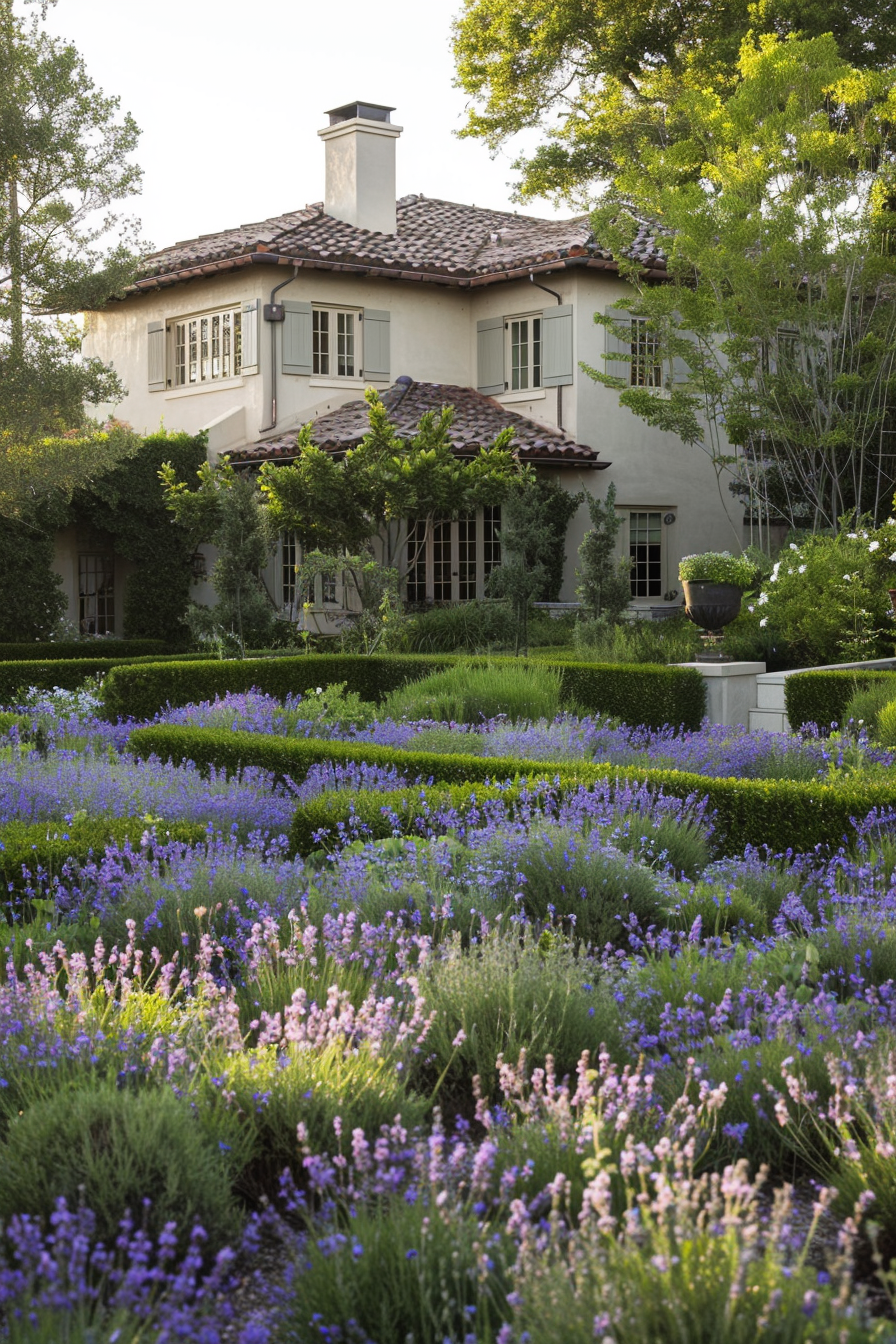
6. Garden Phlox and Blue Point Juniper: Bold and Upright
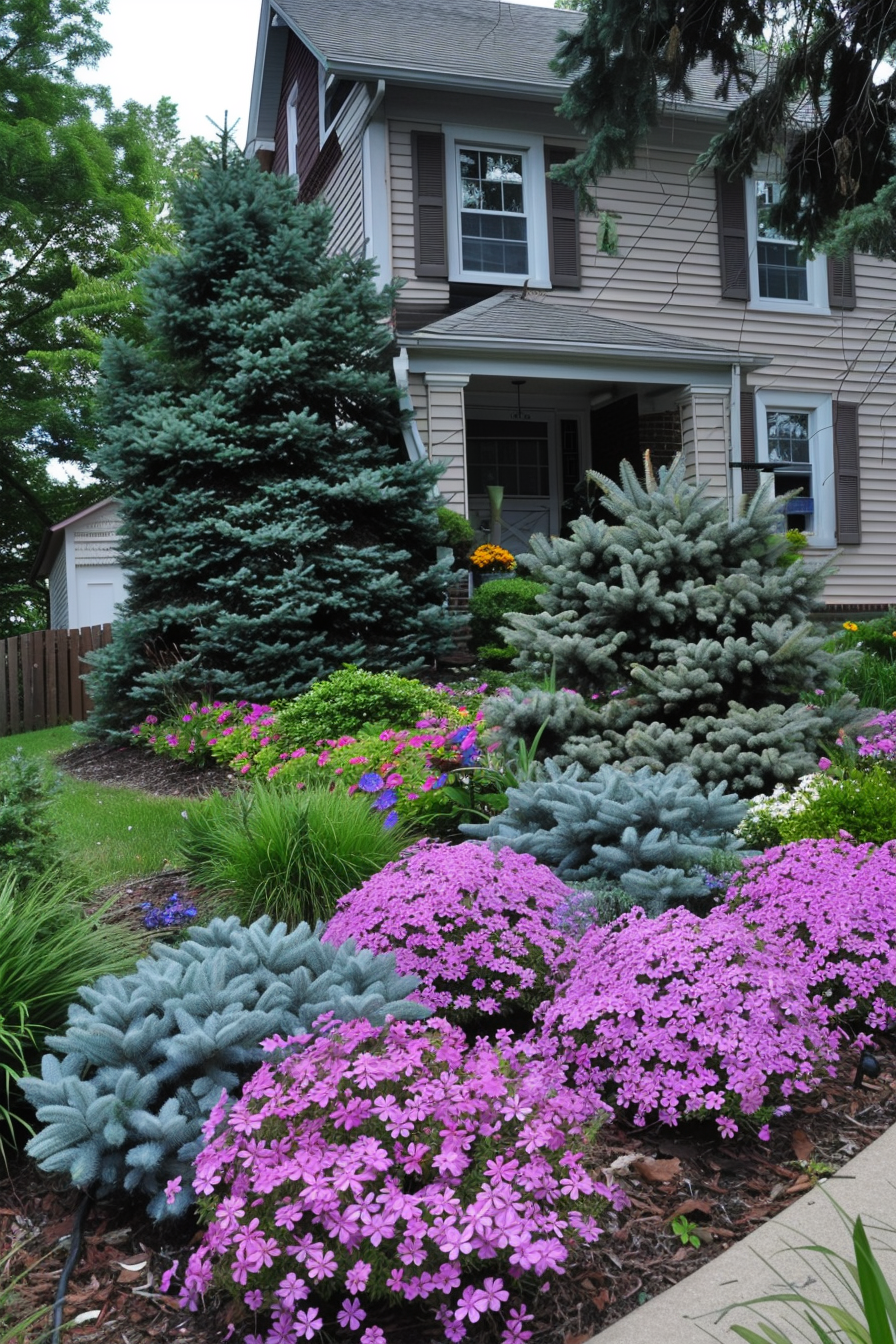
Garden Phlox (Phlox paniculata) brings bold color and a delightful fragrance to the garden with its large clusters of blooms in shades of pink, purple, and white. This upright perennial thrives in full sun to partial shade and attracts a variety of pollinators. Pairing Garden Phlox with the structured, blue-green foliage of Blue Point Juniper (Juniperus chinensis ‘Blue Point’) creates a striking combination that blends the softness of flowers with the strong vertical presence of evergreen shrubs.
Plant Garden Phlox in groups or drifts along borders or as a colorful focal point in the front yard. Position Blue Point Junipers as upright accents or use them to create a living screen that adds privacy and structure. The contrast between the vibrant, airy flowers of the Phlox and the dense, needle-like foliage of the Juniper provides a dynamic visual appeal, making this combination a standout feature in any landscape.
For a cohesive look, consider underplanting with groundcovers or low-growing perennials that complement the color palette of the Garden Phlox. This will create a layered effect that enhances the overall design. With their bold colors and strong forms, Garden Phlox and Blue Point Juniper will bring a sense of elegance and structure to your front yard.
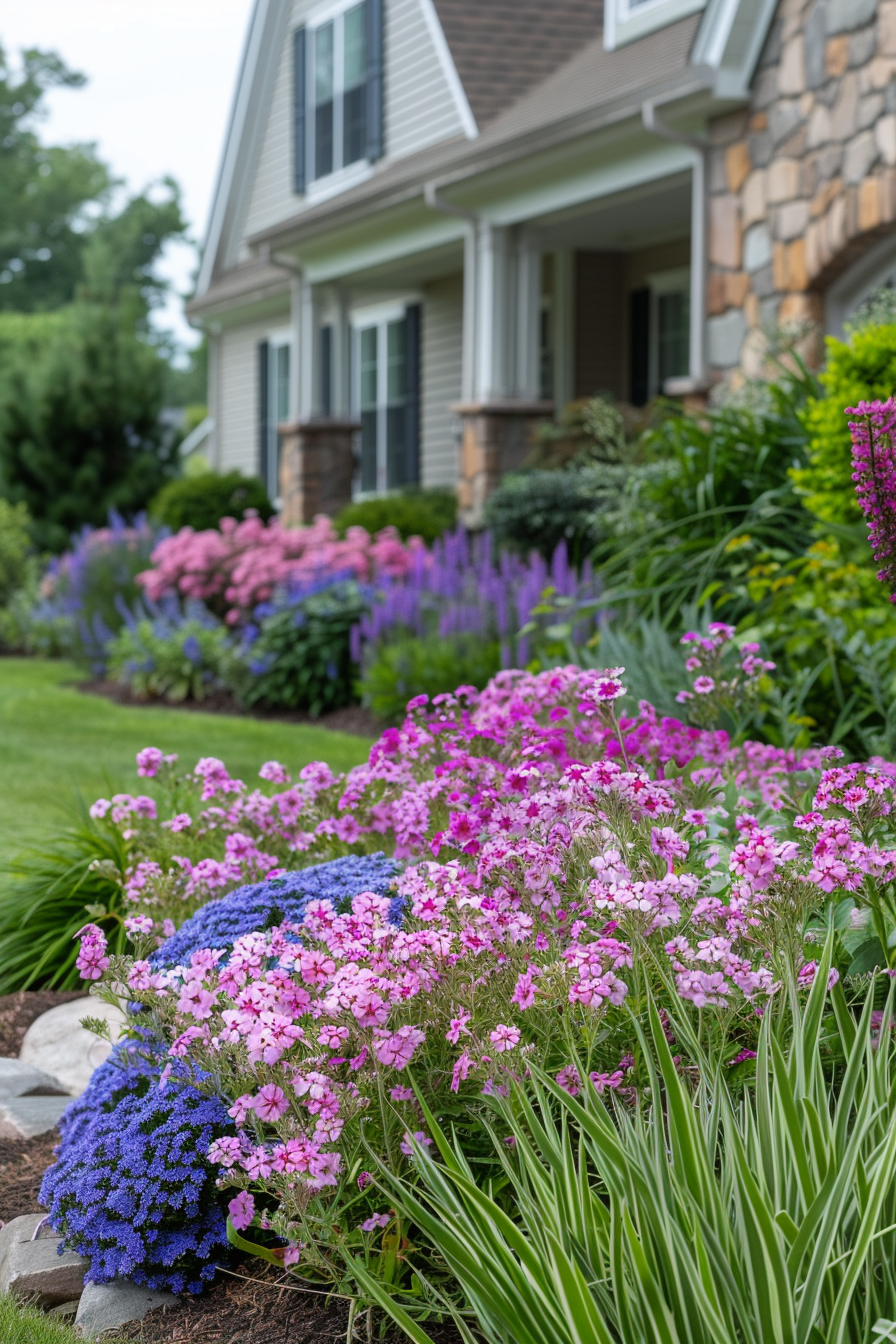
7. Bee Balm and Ice Dance Sedge: Wild and Refined
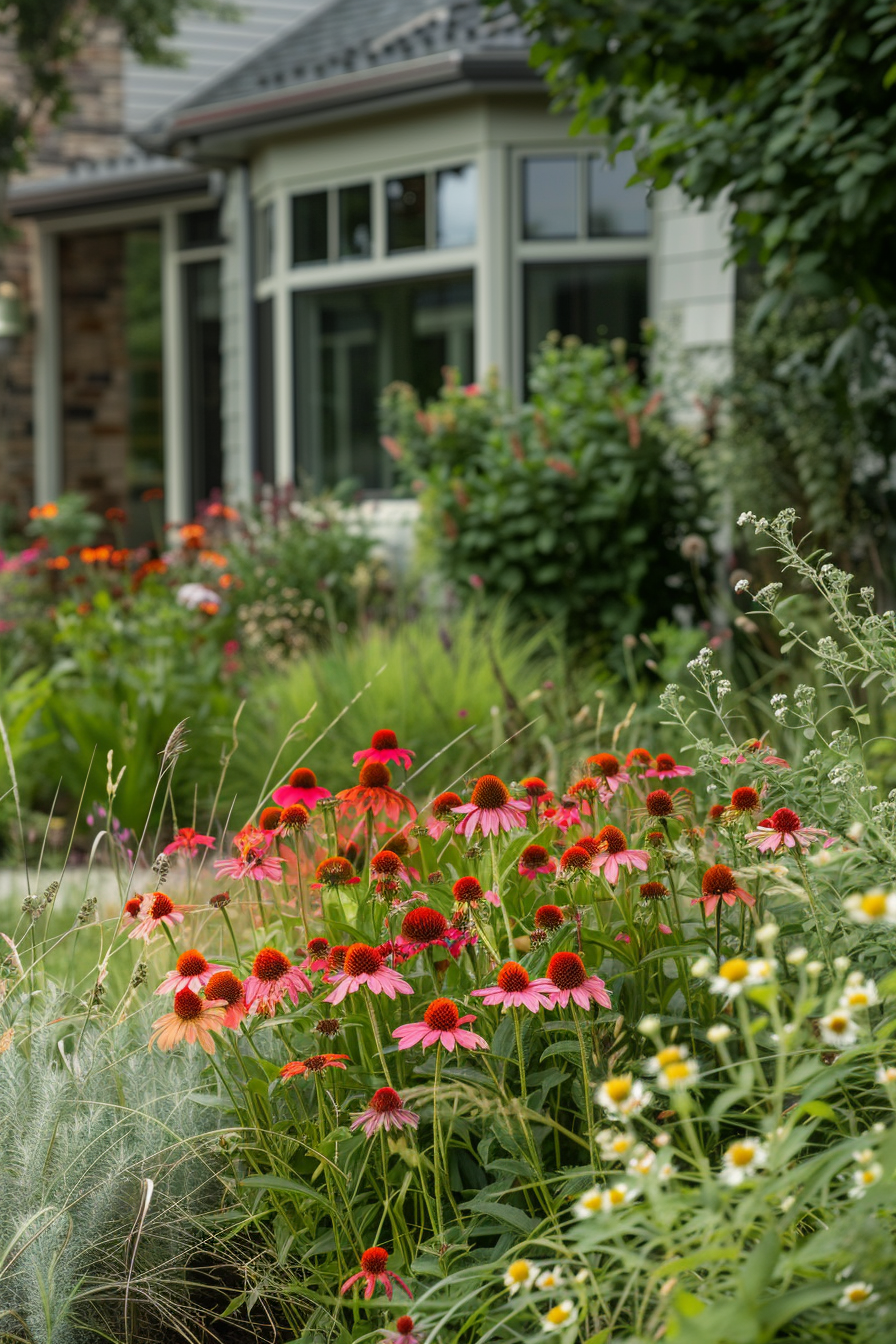
Bee Balm (Monarda didyma) is known for its vibrant, tubular flowers in shades of red, pink, and purple, which attract hummingbirds, bees, and butterflies. This native perennial thrives in full sun to partial shade and adds a splash of wild, meadow-like beauty to any garden. Pairing Bee Balm with the refined, variegated foliage of Ice Dance Sedge (Carex morrowii ‘Ice Dance’) creates a balanced combination that blends the exuberance of wildflowers with the calm, structured appearance of ornamental grasses.
Plant Bee Balm in clusters or drifts along borders, pathways, or as a colorful focal point in the front yard. Position Ice Dance Sedge as a groundcover or edging plant to complement the bold colors and forms of the Bee Balm. The contrast between the bright, spiky flowers and the elegant, arching blades of the Sedge provides a pleasing balance of textures and colors, making this combination a versatile choice for both formal and informal garden designs.
To enhance their visual appeal, consider adding other native or meadow plants that complement the Bee Balm and Ice Dance Sedge. This will create a cohesive, naturalistic look that fills in spaces and adds depth to your landscape. With their vibrant colors and refined foliage, Bee Balm and Ice Dance Sedge will bring a touch of wild beauty and elegance to your front yard.
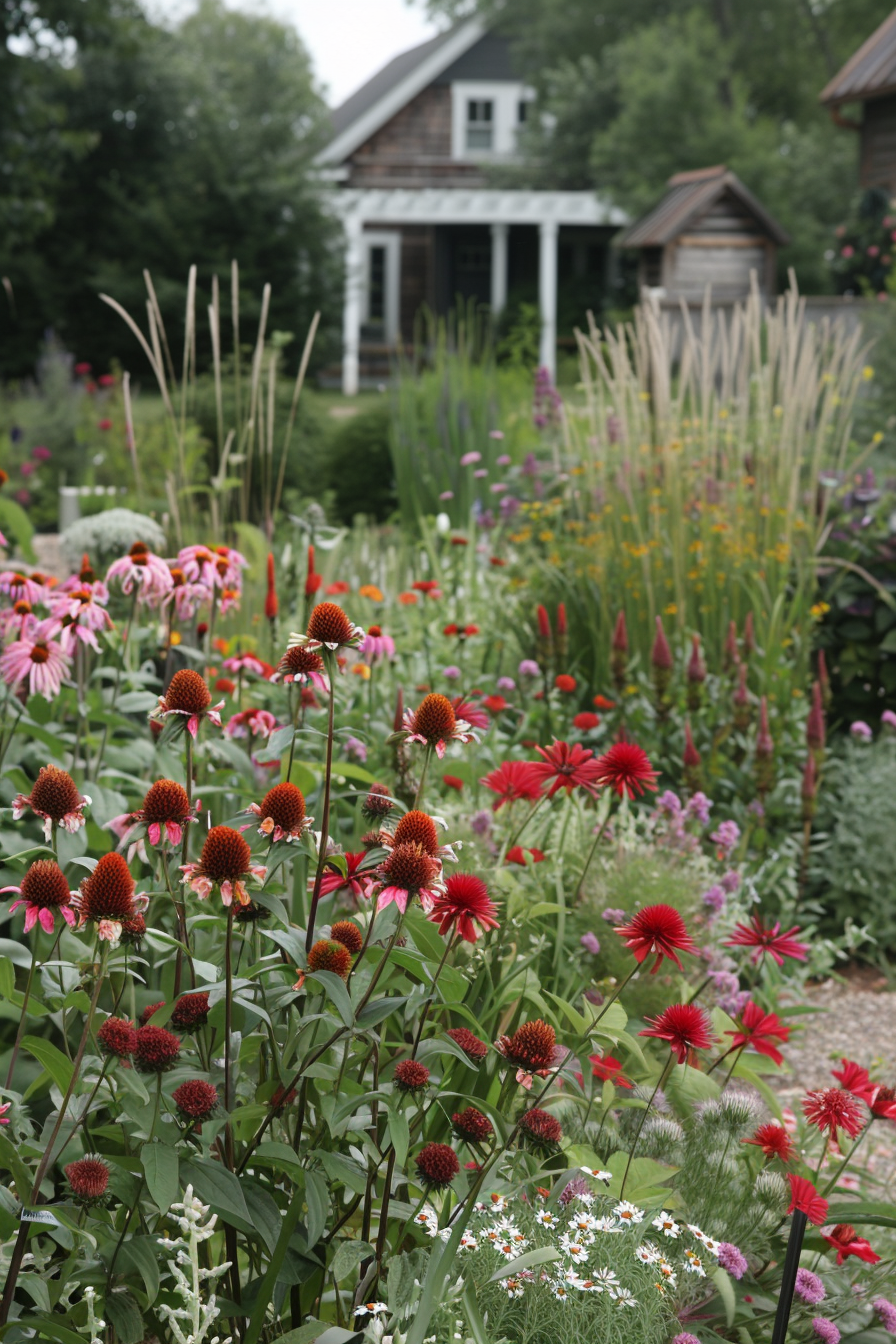
8. Autumn Joy Sedum and Mondo Grass: Season-Spanning Interest
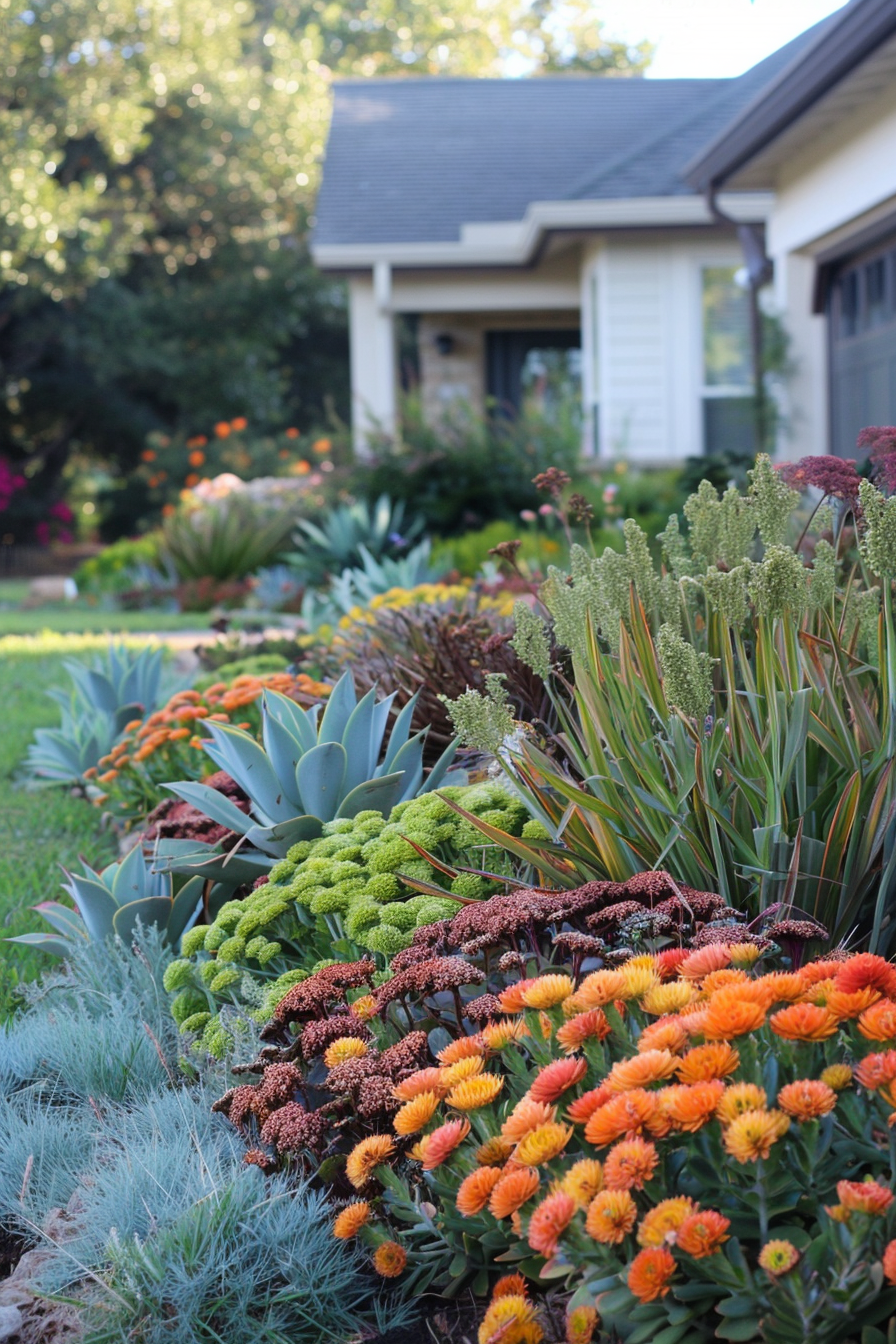
Autumn Joy Sedum (Sedum ‘Autumn Joy’) is a versatile, drought-tolerant perennial known for its succulent leaves and large clusters of pink to bronze flowers that bloom from late summer to fall. This plant provides season-spanning interest with its changing colors and textures. Pairing Autumn Joy Sedum with the low, dense foliage of Mondo Grass (Ophiopogon japonicus) creates a dynamic combination that offers year-round appeal. Mondo Grass, with its dark green or black, grass-like leaves, adds a contrasting texture and evergreen presence to the garden.
Plant Autumn Joy Sedum in sunny, well-drained areas along borders, rock gardens, or as a focal point in your front yard. Position Mondo Grass as a groundcover or edging plant around the Sedum to create a lush, carpet-like effect. The contrast between the succulent, fleshy leaves of the Sedum and the fine, grassy texture of the Mondo Grass provides a visually appealing combination that is both striking and low-maintenance.
For a cohesive look, consider adding other drought-tolerant or succulent plants that complement the Autumn Joy Sedum and Mondo Grass. This will create a layered effect that enhances the overall design and provides additional texture and color. With their ability to thrive in challenging conditions and their season-spanning interest, Autumn Joy Sedum and Mondo Grass will bring a touch of enduring beauty to your front yard.
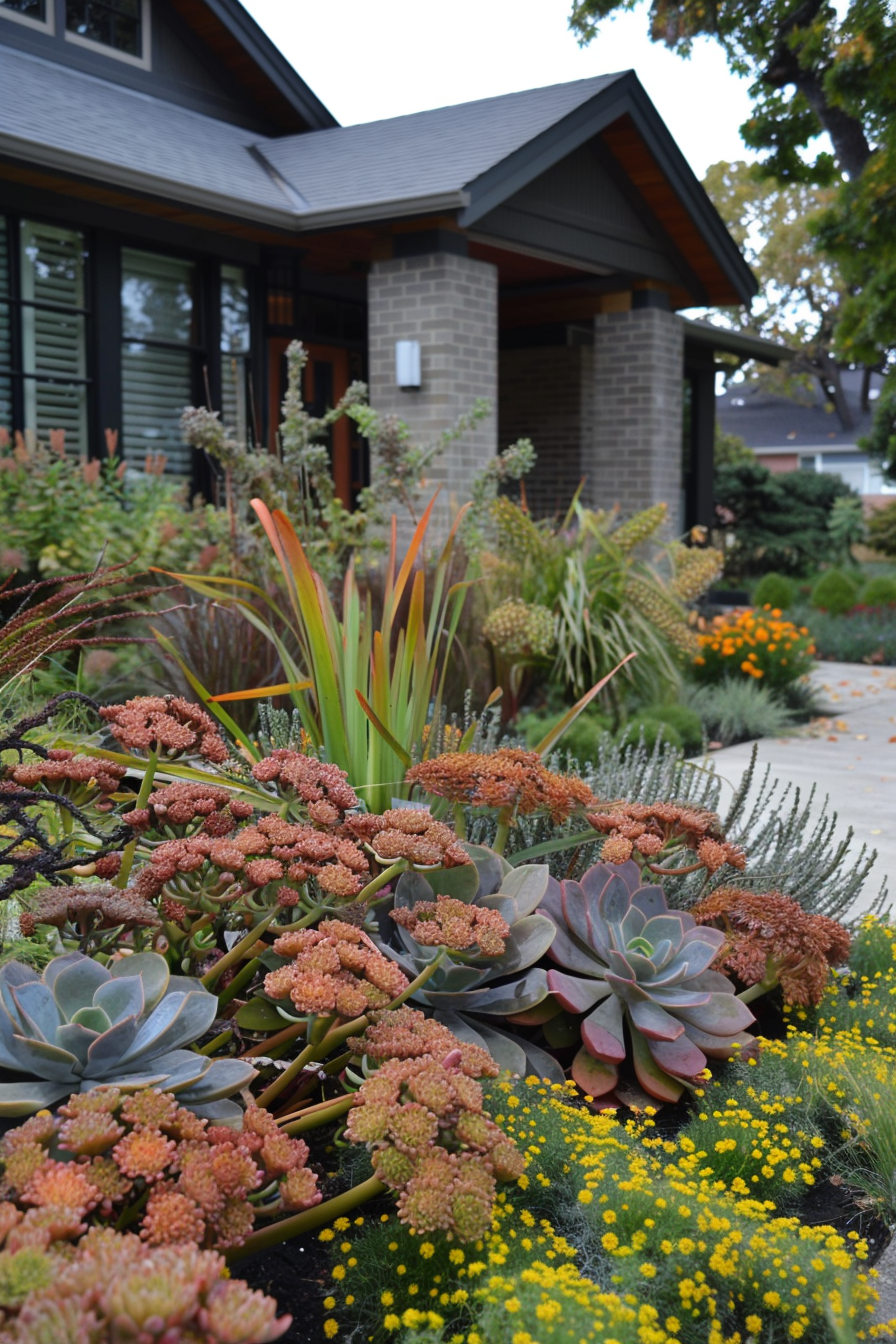
9. Coral Bells and Japanese Yew: Colorful and Evergreen
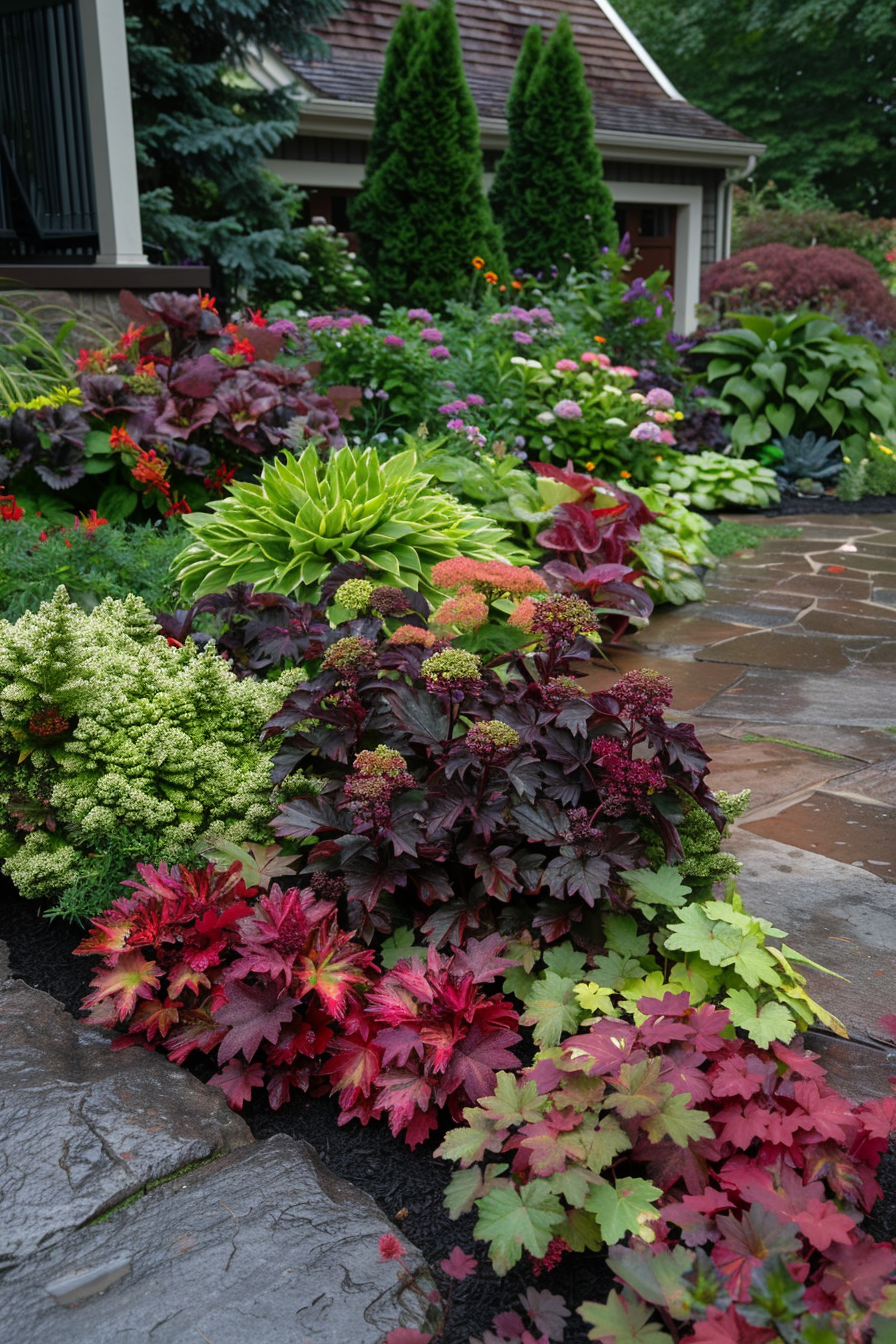
Coral Bells (Heuchera spp.) are prized for their colorful, scalloped foliage that comes in a variety of shades, from deep burgundy to bright lime green. These perennials add year-round interest with their vibrant leaves and delicate flower spikes. Pairing Coral Bells with the dense, evergreen foliage of Japanese Yew (Taxus cuspidata) creates a combination that blends vibrant color with structural form. Japanese Yew provides a rich, green backdrop that highlights the vivid hues of the Coral Bells.
Plant Coral Bells in shaded or partially shaded areas along borders, pathways, or as groundcovers in front of Japanese Yew. Position the Yews as upright accents or use them to create a living screen that adds privacy and structure. The contrast between the colorful foliage of the Coral Bells and the dense, needle-like leaves of the Japanese Yew provides a pleasing balance of textures and colors, making this combination a versatile choice for both formal and informal garden designs.
To enhance their visual appeal, consider adding other shade-loving perennials or groundcovers that complement the Coral Bells and Japanese Yew. This will create a cohesive, layered look that fills in spaces and adds depth to your landscape. With their vibrant colors and evergreen presence, Coral Bells and Japanese Yew will bring a touch of enduring beauty and structure to your front yard.
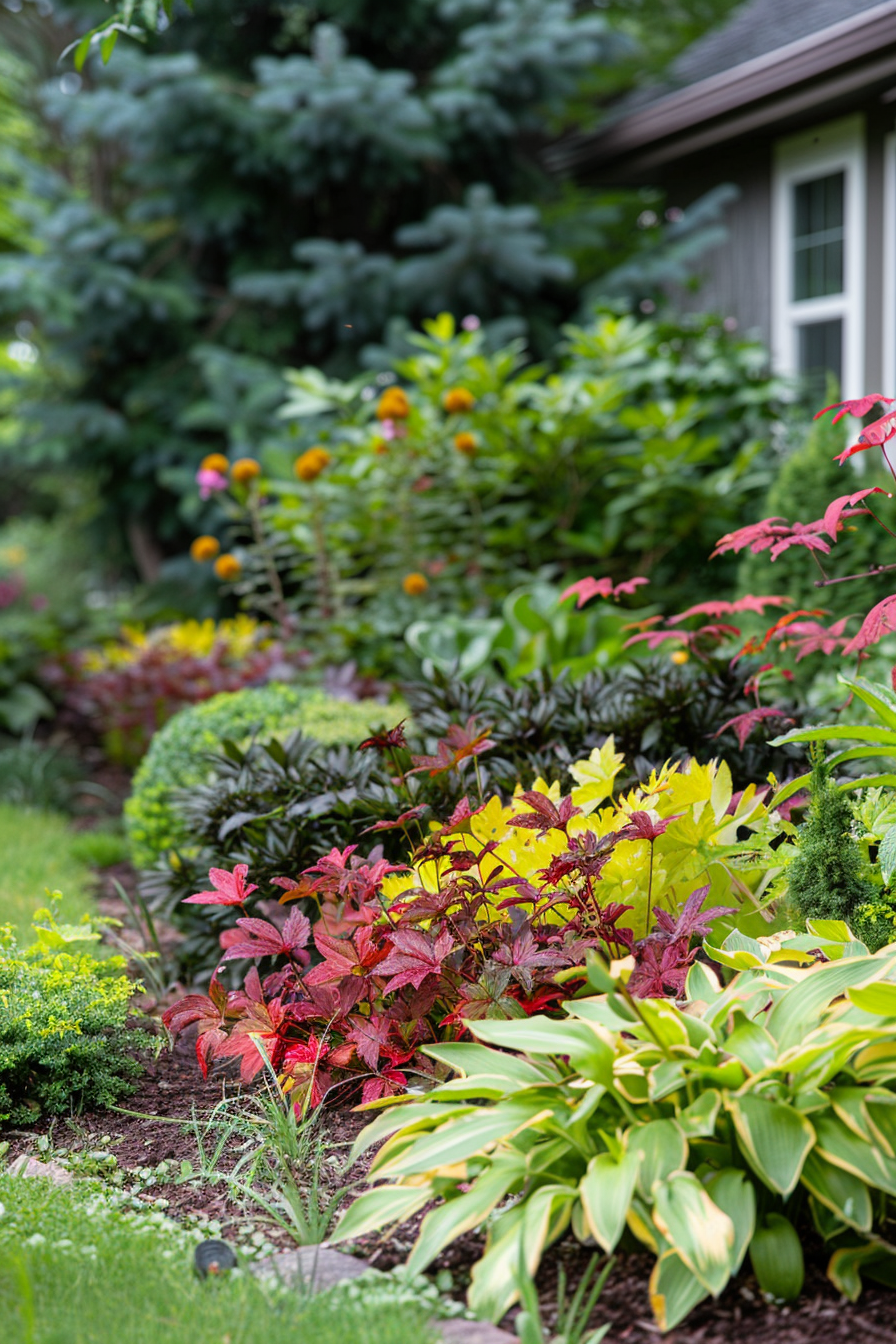
10. Black-Eyed Susan and Maiden Grass: Bold and Graceful
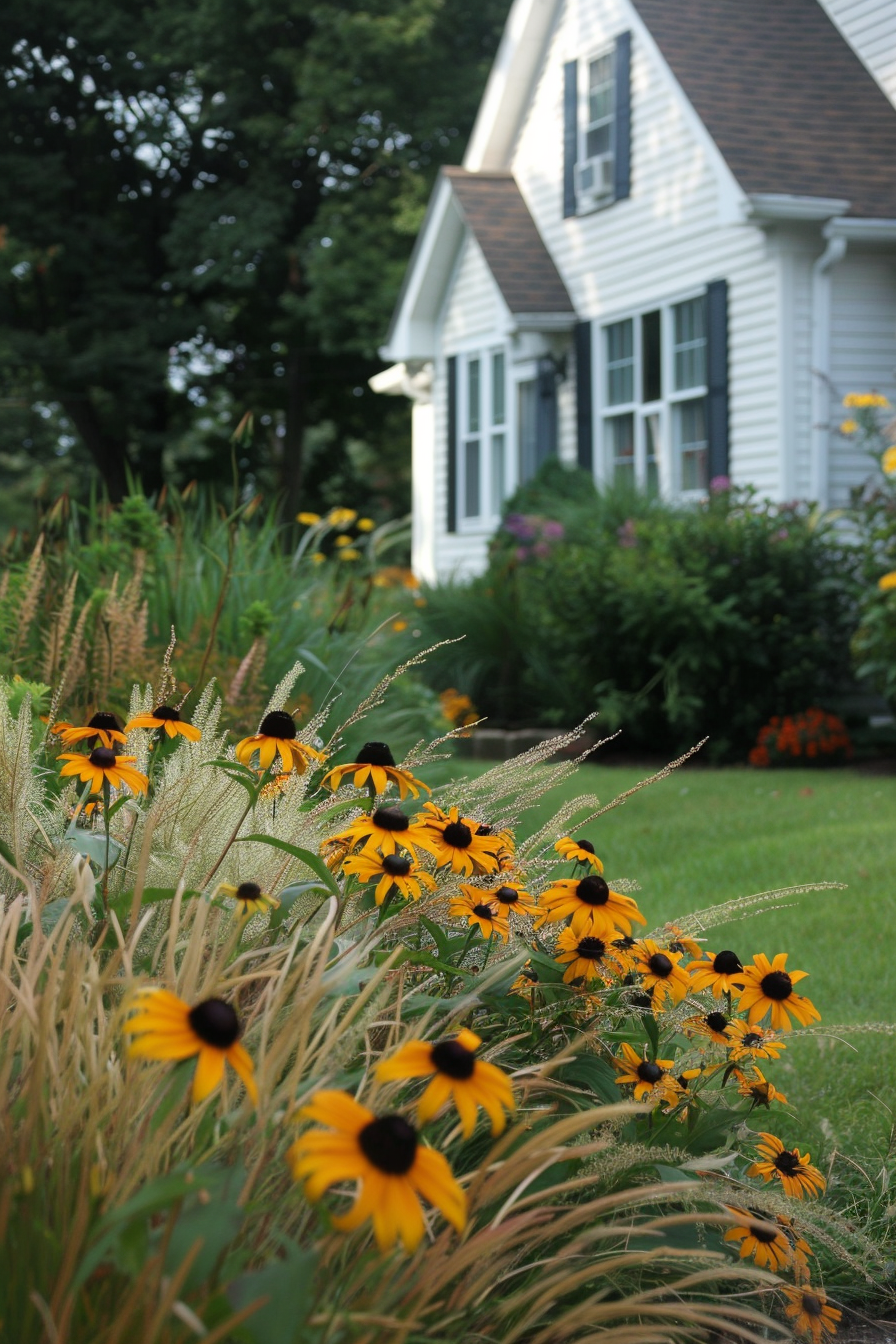
Black-Eyed Susan (Rudbeckia fulgida) is a hardy perennial known for its bright, golden-yellow flowers with dark centers that bloom from mid-summer to fall. These cheerful flowers add a burst of color and attract a variety of pollinators. Pairing Black-Eyed Susan with the graceful, arching plumes of Maiden Grass (Miscanthus sinensis) creates a landscape that combines the boldness of flowers with the airy elegance of ornamental grasses. Maiden Grass adds texture and movement to the garden, especially when its feathery plumes sway in the breeze.
Plant Black-Eyed Susan in sunny areas along borders, pathways, or as a colorful focal point in the front yard. Position Maiden Grass as a backdrop or use it to create soft screens that add privacy while maintaining an open feel. The contrast between the vibrant, golden-yellow flowers of the Black-Eyed Susan and the silvery-green, feathery foliage of the Maiden Grass provides a pleasing balance of textures and colors, making this combination a standout feature in any landscape.
For a cohesive look, consider adding other native or drought-tolerant plants to complement the Black-Eyed Susan and Maiden Grass. This will create a layered effect that enhances the overall design and provides additional texture and color. With their bold colors and graceful forms, Black-Eyed Susan and Maiden Grass will bring a touch of sunny charm and elegance to your front yard.
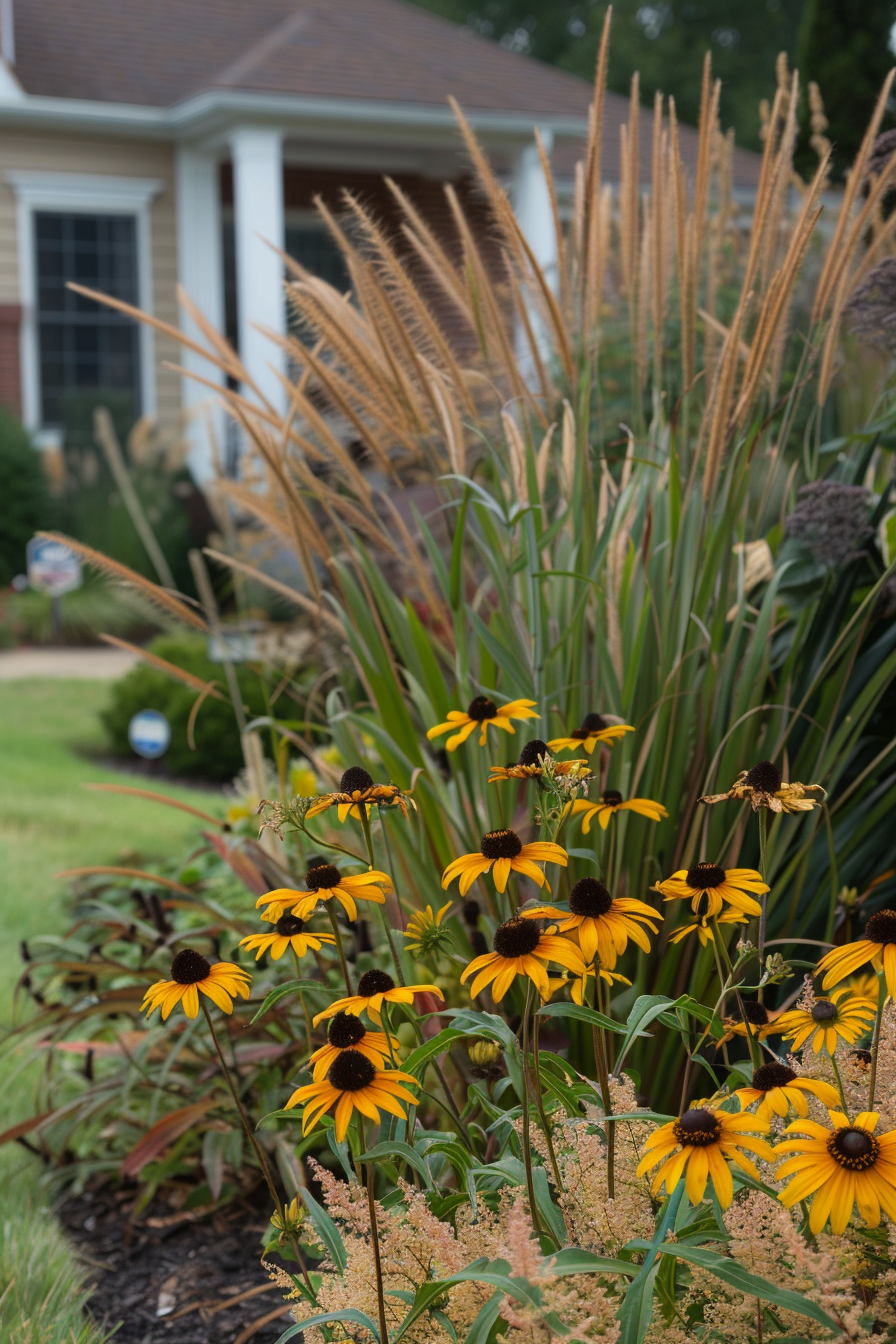
11. Clematis and Boxwood: Climbing Beauty and Evergreen Structure
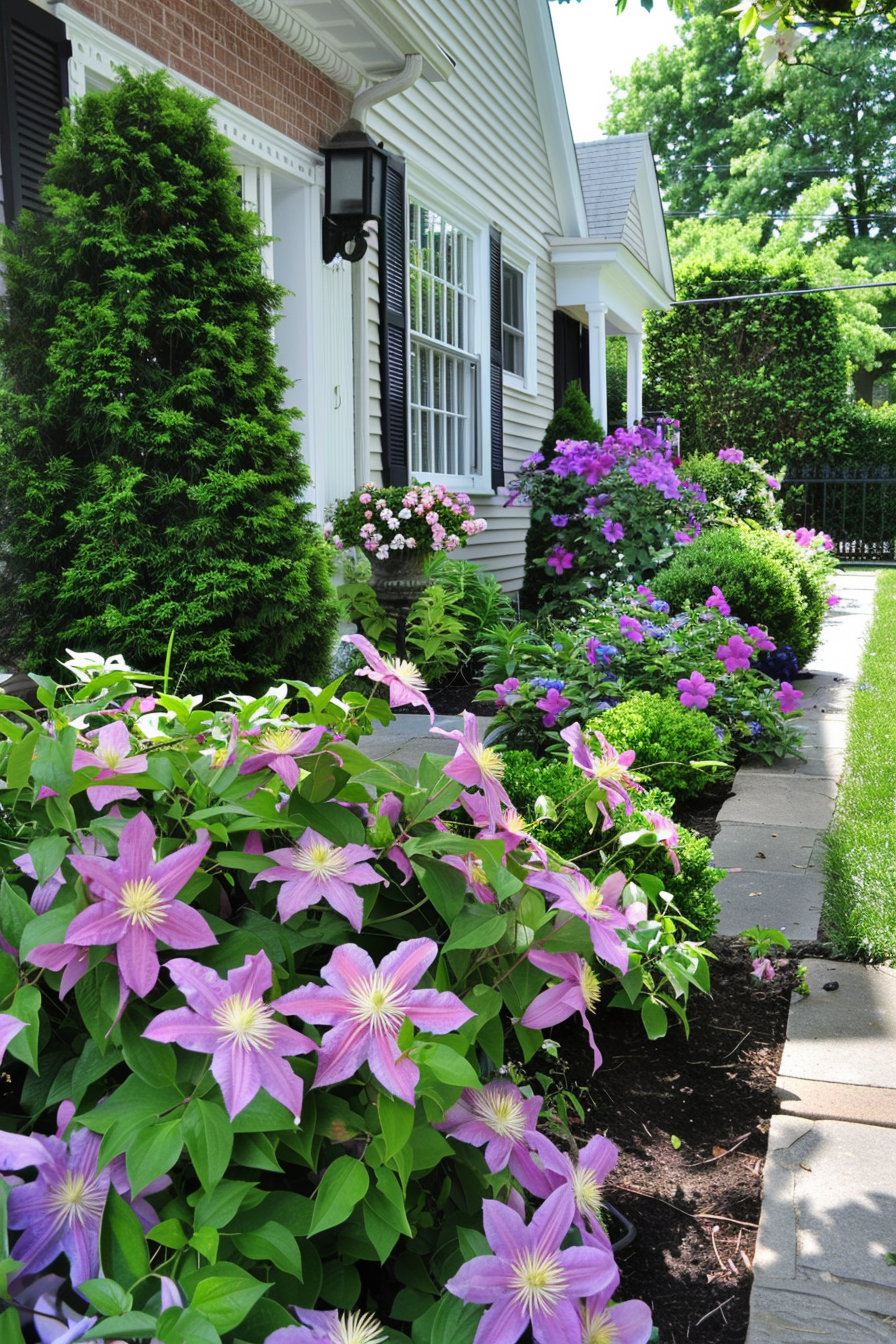
Clematis (Clematis spp.) are beloved for their large, star-shaped flowers that come in a variety of colors and bloom throughout the growing season. These climbing perennials add vertical interest and can be trained to grow on trellises, fences, or arbors. Pairing Clematis with the dense, evergreen foliage of Boxwood (Buxus sempervirens) creates a combination that blends the climbing beauty of flowers with the structured form of shrubs. Boxwood’s neat, green foliage provides a solid backdrop that enhances the vibrant blooms of the Clematis.
Plant Clematis in sunny to partially shaded areas where they can climb and spread their vibrant flowers. Position Boxwood along walkways, driveways, or as a foundation planting to frame the Clematis and provide year-round greenery. The contrast between the lush, climbing flowers of the Clematis and the tidy, evergreen foliage of the Boxwood creates a visually appealing balance of textures and colors, making this combination a versatile choice for both formal and informal garden designs.
To maintain their beauty, ensure the Clematis receives adequate support and is pruned regularly to promote healthy growth. Boxwood should be trimmed to maintain its shape and density. Together, Clematis and Boxwood create a front yard that is not only visually appealing but also filled with the lush, climbing beauty of flowers, making it a perfect welcome for any home.
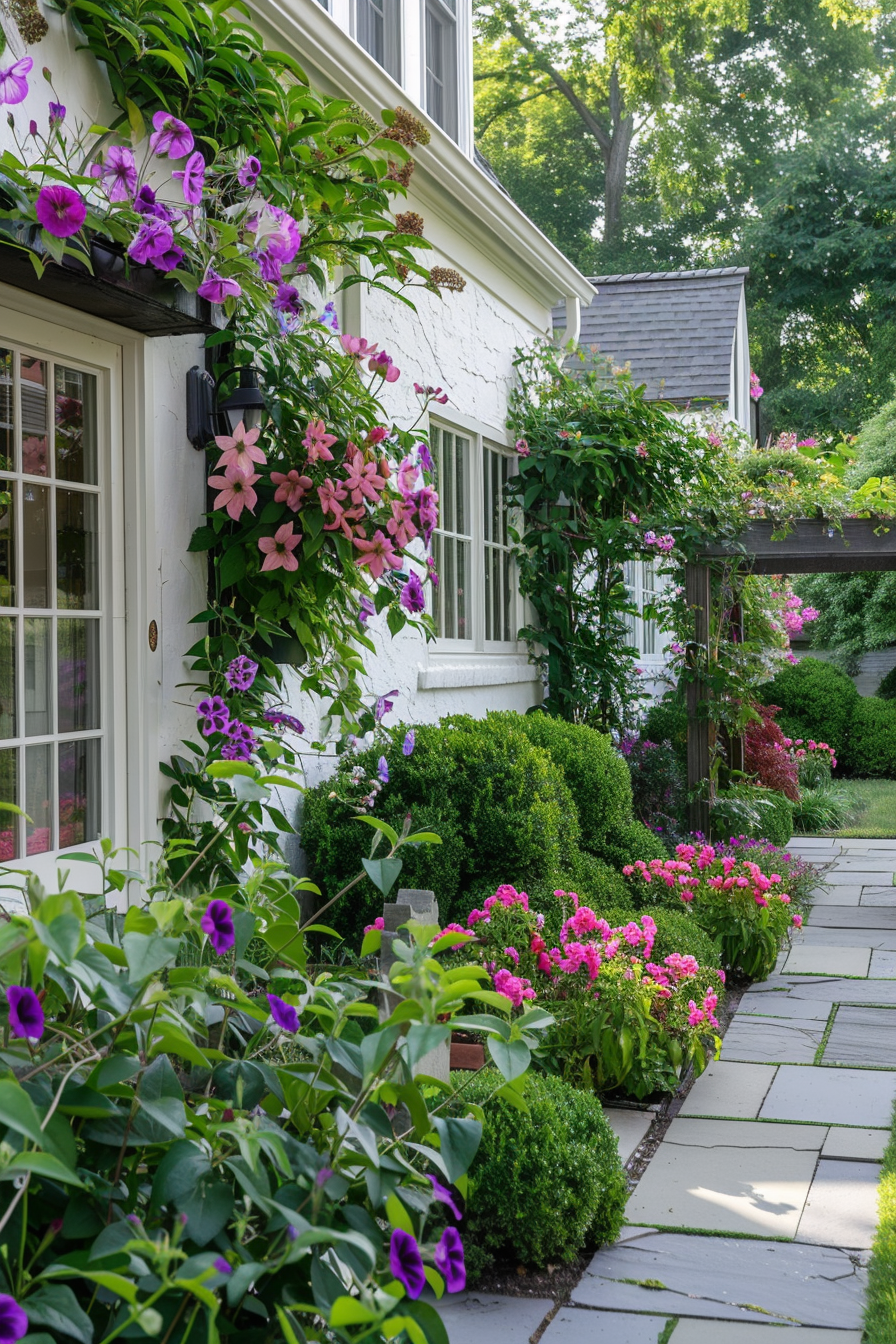
12. False Spirea and American Arborvitae: Feathery and Evergreen
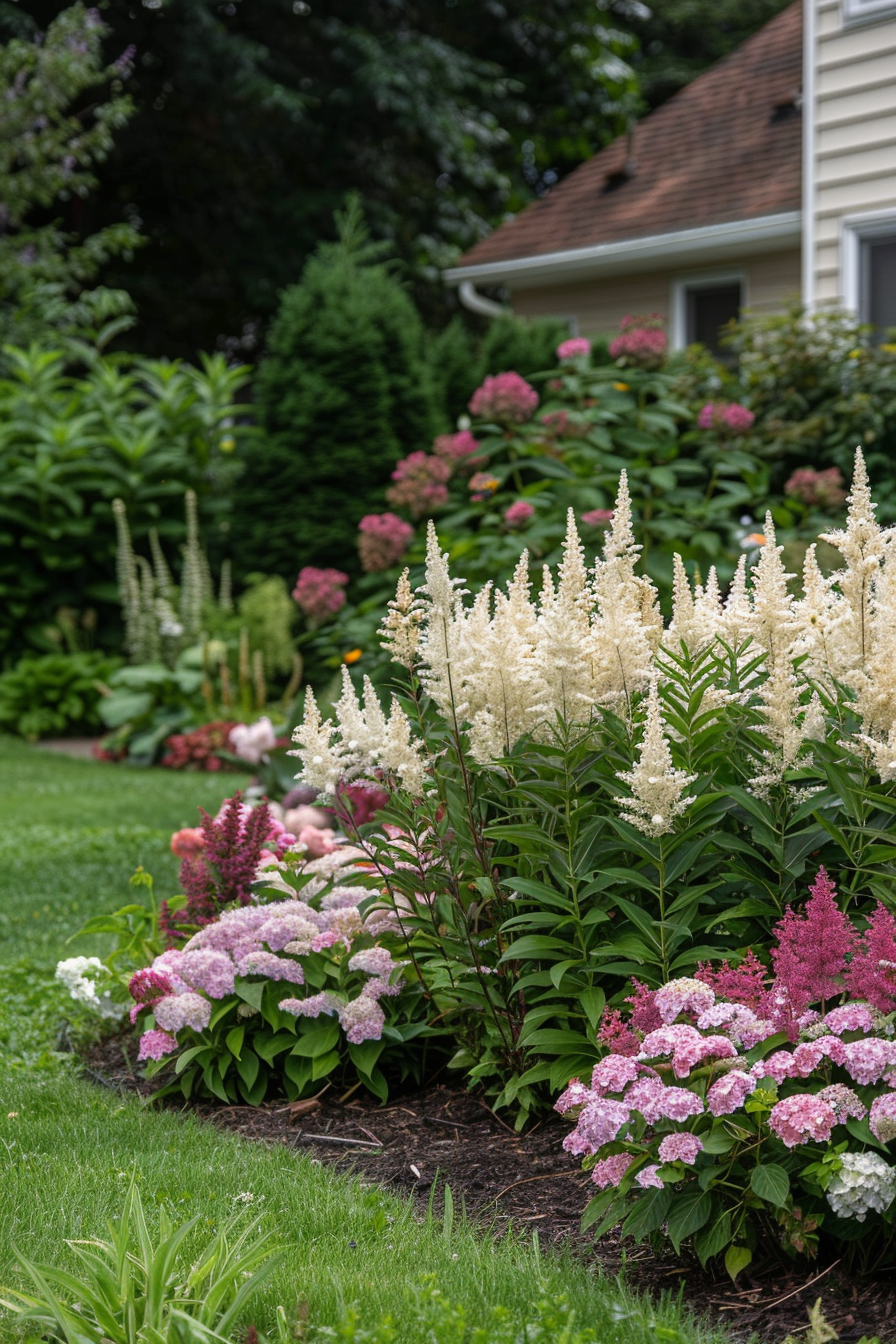
False Spirea (Astilbe spp.) is known for its feathery plumes of flowers in shades of white, pink, and red that bloom in early to mid-summer. These perennials thrive in moist, shaded areas and add a touch of soft, airy beauty to the garden. Pairing False Spirea with the dense, upright foliage of American Arborvitae (Thuja occidentalis) creates a combination that blends the delicate texture of flowers with the strong vertical presence of evergreen shrubs. American Arborvitae provides a rich, green backdrop that highlights the vibrant plumes of the False Spirea.
Plant False Spirea in shaded or partially shaded areas along borders, pathways, or as groundcovers in front of American Arborvitae. Position the Arborvitae as upright accents or use them to create a living screen that adds privacy and structure. The contrast between the feathery, airy flowers of the False Spirea and the dense, needle-like foliage of the American Arborvitae provides a pleasing balance of textures and colors, making this combination a versatile choice for both formal and informal garden designs.
To enhance their visual appeal, consider adding other shade-loving perennials or groundcovers that complement the False Spirea and American Arborvitae. This will create a cohesive, layered look that fills in spaces and adds depth to your landscape. With their vibrant colors and evergreen presence, False Spirea and American Arborvitae will bring a touch of soft beauty and structure to your front yard.
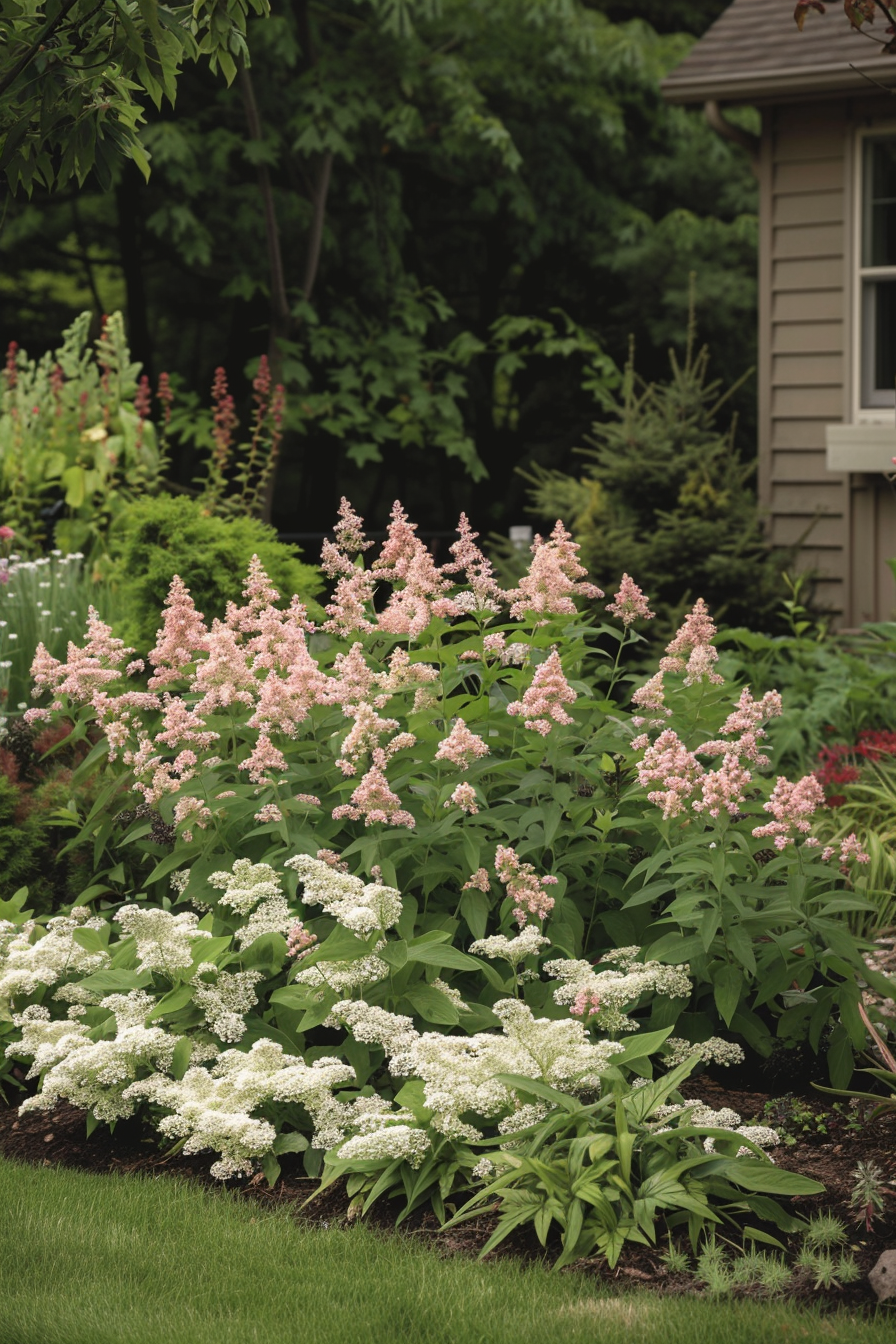
13. Bearded Iris and Golden Mop False Cypress: Colorful and Cascading
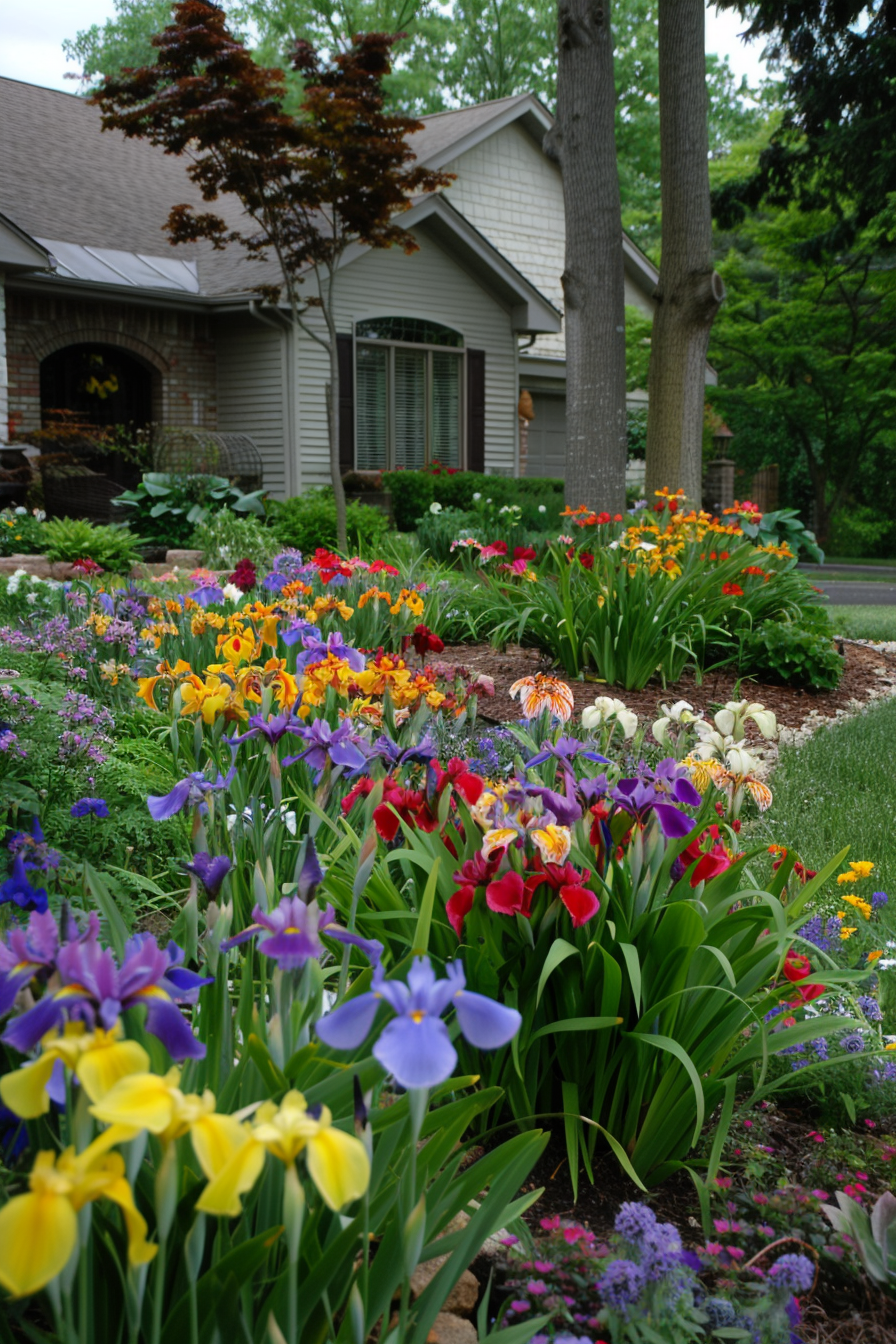
Bearded Iris (Iris germanica) are known for their striking, sword-like leaves and large, colorful flowers that bloom in late spring to early summer. These perennials add a bold splash of color and are available in a wide range of hues. Pairing Bearded Iris with the cascading, golden foliage of Golden Mop False Cypress (Chamaecyparis pisifera ‘Golden Mop’) creates a combination that blends the bold colors of flowers with the soft, flowing form of evergreens. Golden Mop False Cypress provides a bright, golden backdrop that enhances the vibrant blooms of the Bearded Iris.
Plant Bearded Iris in sunny, well-drained areas along borders, pathways, or as a colorful focal point in the front yard. Position Golden Mop False Cypress as a cascading groundcover or use it to create soft mounds that add texture and color. The contrast between the bold, colorful flowers of the Bearded Iris and the soft, golden foliage of the False Cypress provides a visually appealing balance of textures and colors, making this combination a standout feature in any landscape.
For a cohesive look, consider adding other drought-tolerant or low-growing plants that complement the Bearded Iris and Golden Mop False Cypress. This will create a layered effect that enhances the overall design and provides additional texture and color. With their vibrant colors and cascading forms, Bearded Iris and Golden Mop False Cypress will bring a touch of bold beauty and elegance to your front yard.
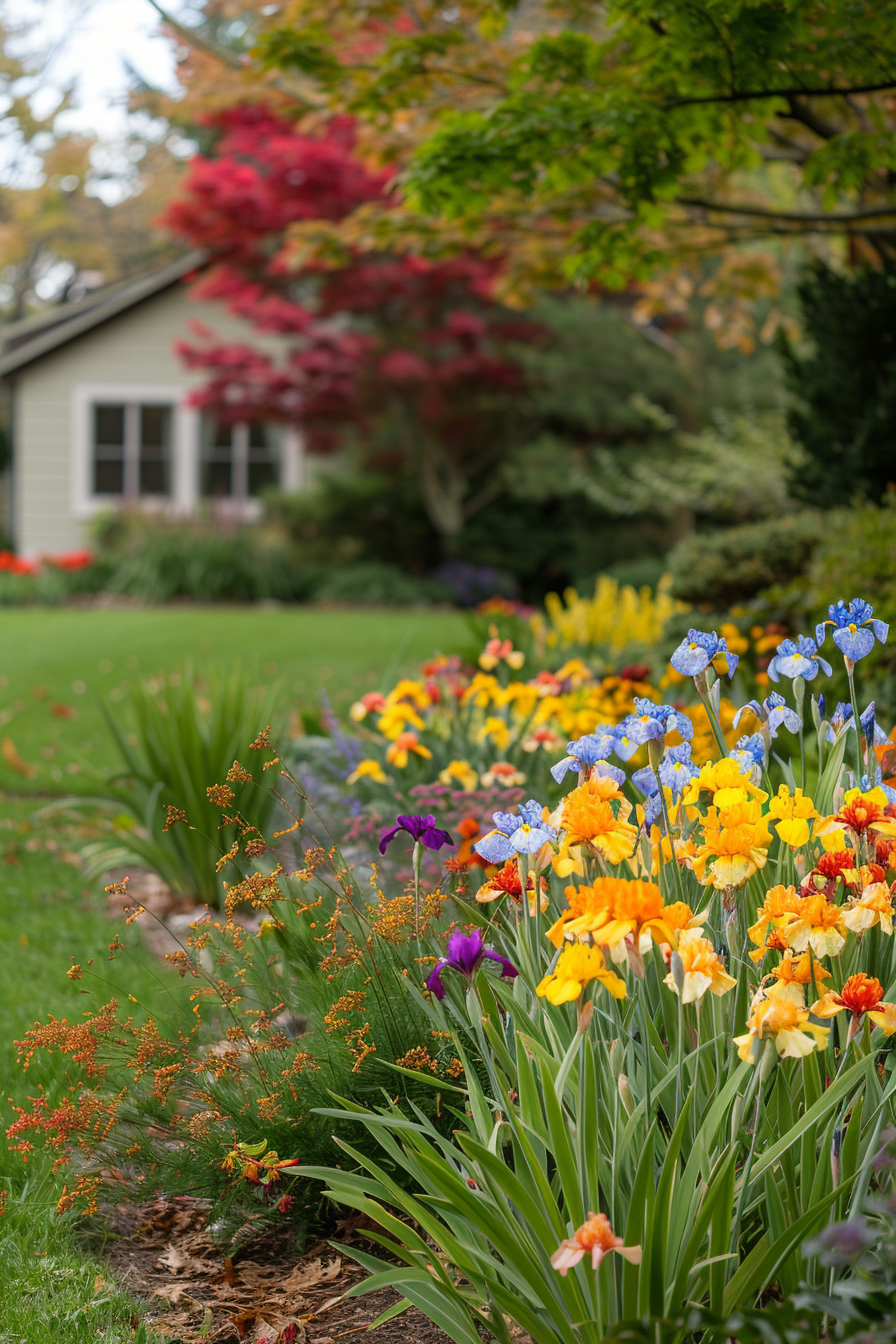
14. Daylilies and Japanese Spurge: Colorful and Ground-Hugging
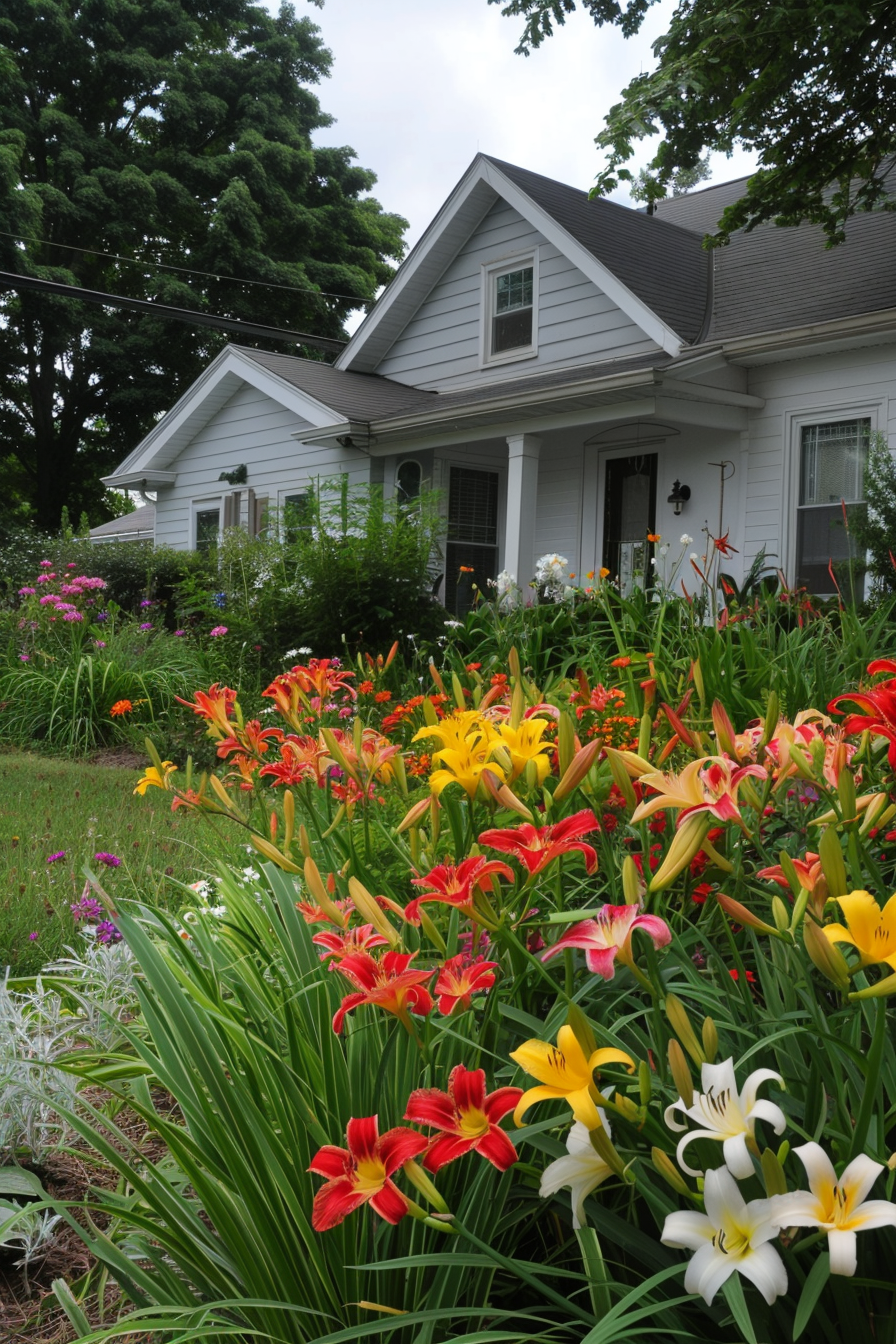
Daylilies (Hemerocallis spp.) are versatile and easy-to-grow perennials known for their vibrant, trumpet-shaped flowers that bloom throughout the summer. Their wide range of colors makes them a flexible choice for any garden design. Pairing Daylilies with the low, dense foliage of Japanese Spurge (Pachysandra terminalis) creates a combination that blends the lushness of flowers with the ground-hugging form of evergreen groundcovers. Japanese Spurge provides a rich, green backdrop that highlights the colorful blooms of the Daylilies.
Plant Daylilies in sunny, well-drained areas along borders, pathways, or as a colorful focal point in the front yard. Position Japanese Spurge as a groundcover around the Daylilies to create a lush, carpet-like effect. The contrast between the vibrant, trumpet-shaped flowers of the Daylilies and the dense, evergreen foliage of the Japanese Spurge provides a visually appealing balance of textures and colors, making this combination a versatile choice for both formal and informal garden designs.
To enhance their visual appeal, consider adding other drought-tolerant or low-growing plants that complement the Daylilies and Japanese Spurge. This will create a layered effect that enhances the overall design and provides additional texture and color. With their vibrant colors and ground-hugging forms, Daylilies and Japanese Spurge will bring a touch of enduring beauty and structure to your front yard.
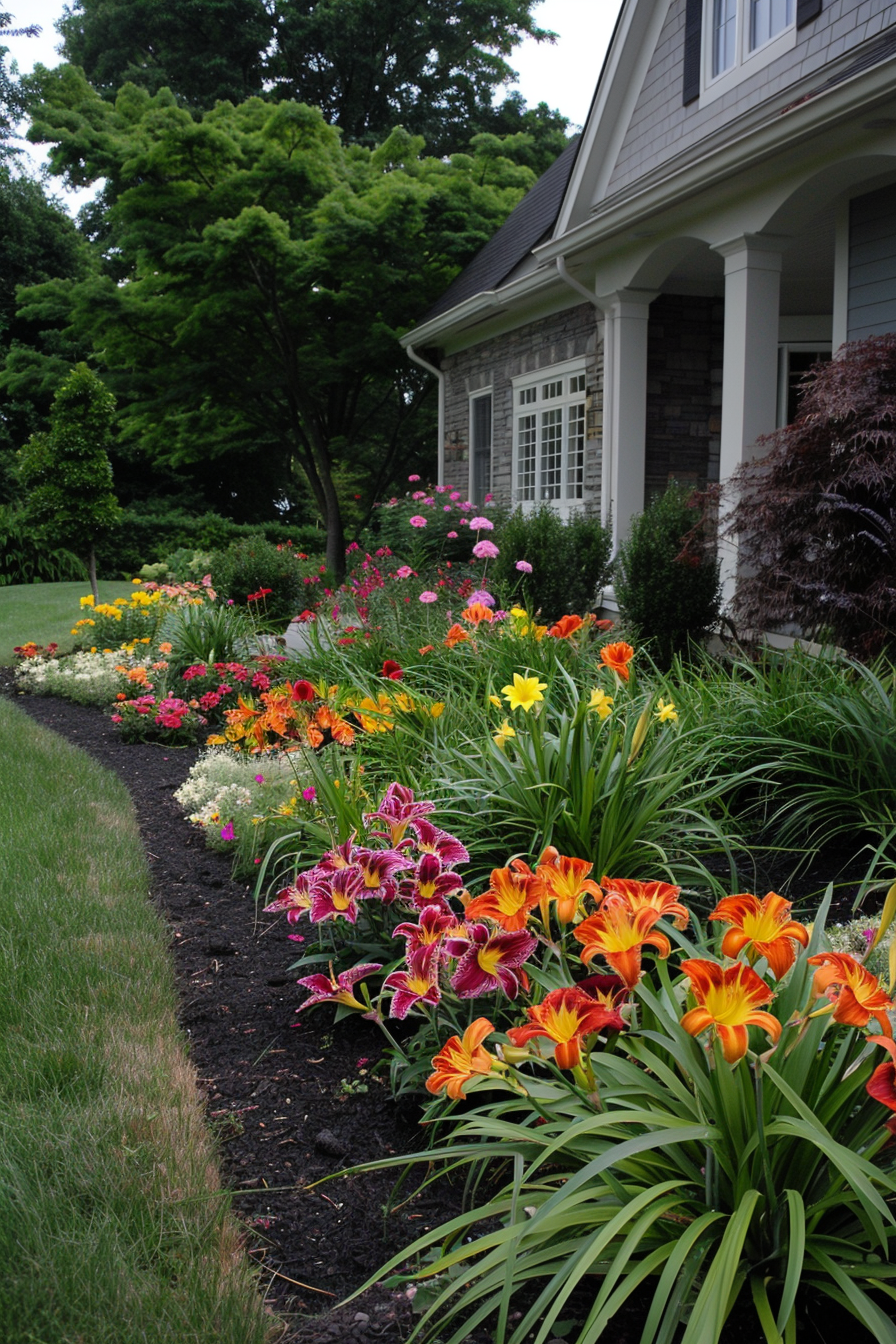
15. Peony and Festuca: Lush Blooms and Silver Foliage
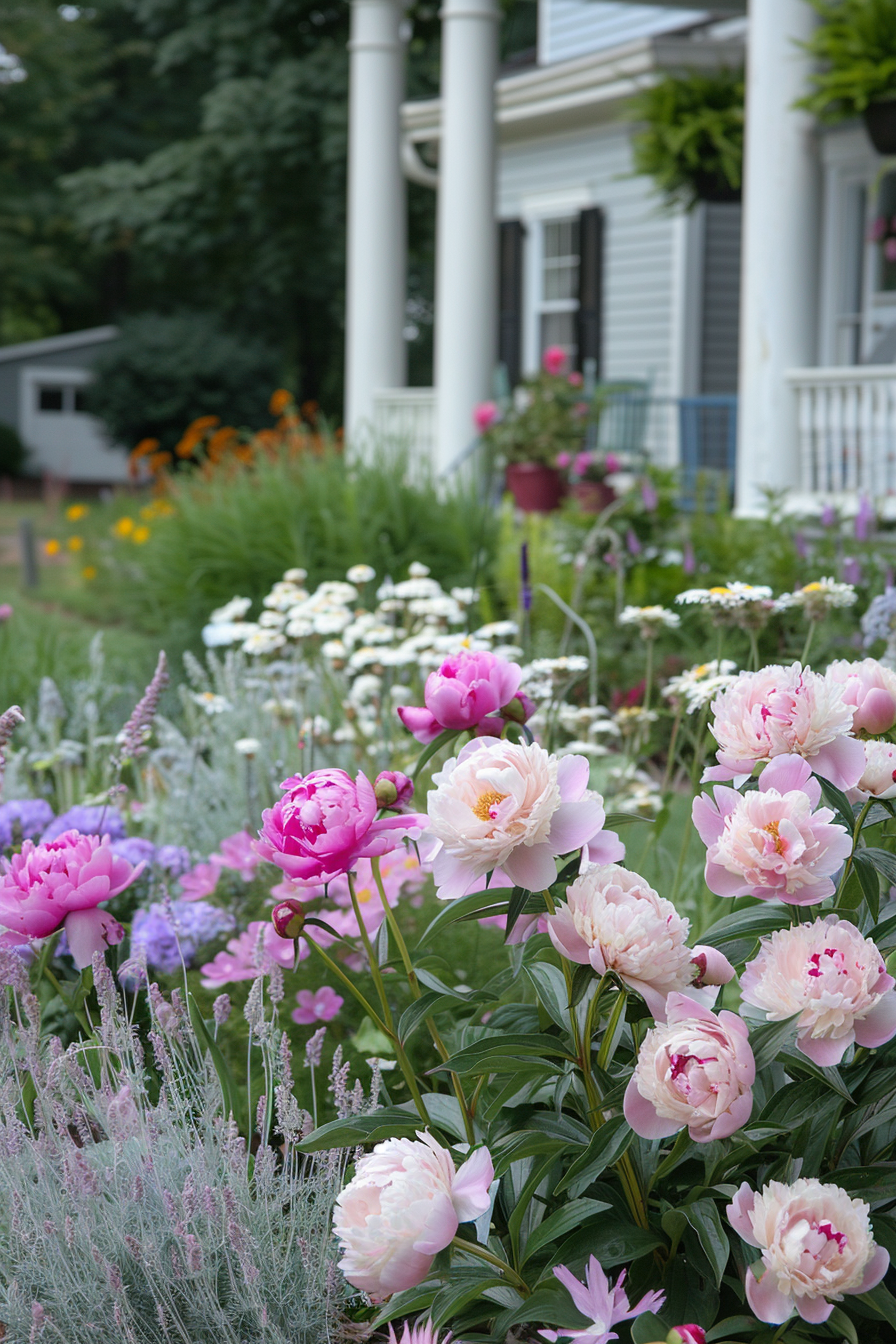
Peonies (Paeonia lactiflora) are beloved for their large, fragrant blooms that add a touch of elegance to any garden. These perennials are best planted in a spot that receives full sun to partial shade. When paired with the fine, silver-blue foliage of Festuca (Festuca glauca), they create a stunning contrast. The peony’s lush flowers, available in various colors, provide a vibrant pop against the Festuca’s delicate, grass-like leaves. Together, they form a breathtaking display of texture and color that enhances any front yard.
To maximize the impact, plant peonies in clusters along pathways or borders where their lush blossoms can be admired up close. Position Festuca as a groundcover or edging plant around the peonies to create a lush, carpet-like effect. This pairing works well in both formal and informal garden designs, offering a blend of structure and softness that appeals to the eye throughout the growing season.
For added visual interest, consider adding other drought-tolerant or low-growing plants that complement the Peonies and Festuca. This will create a layered effect that enhances the overall design and provides additional texture and color. With their lush blooms and fine foliage, Peonies and Festuca will bring a touch of elegance and beauty to your front yard.
